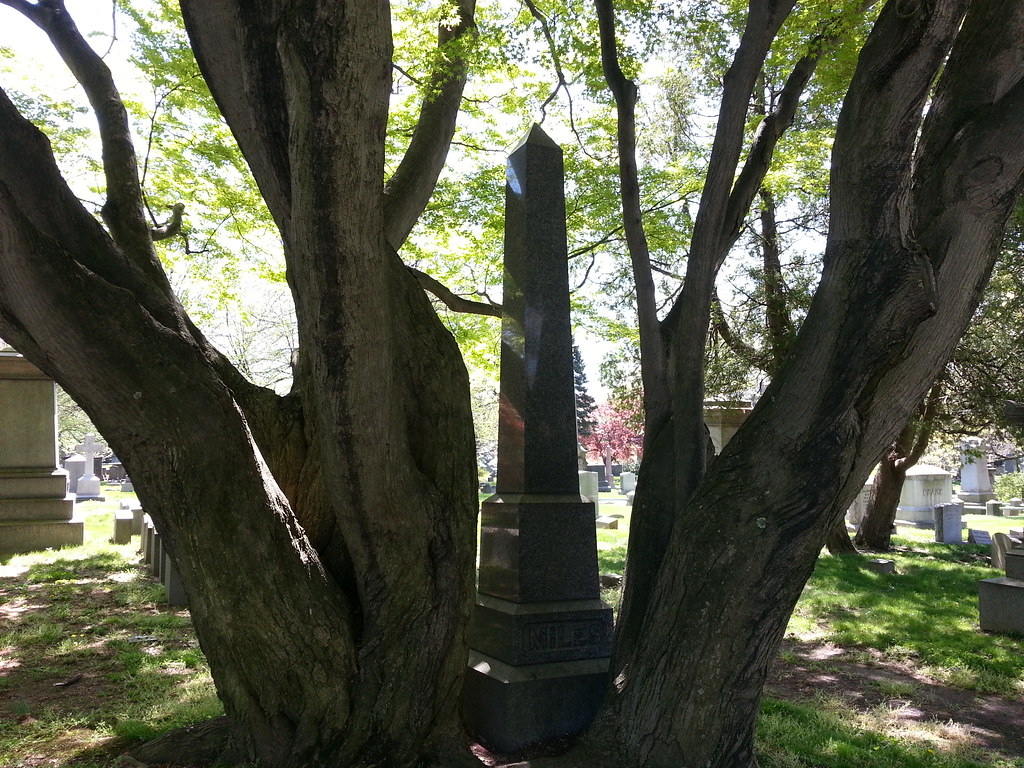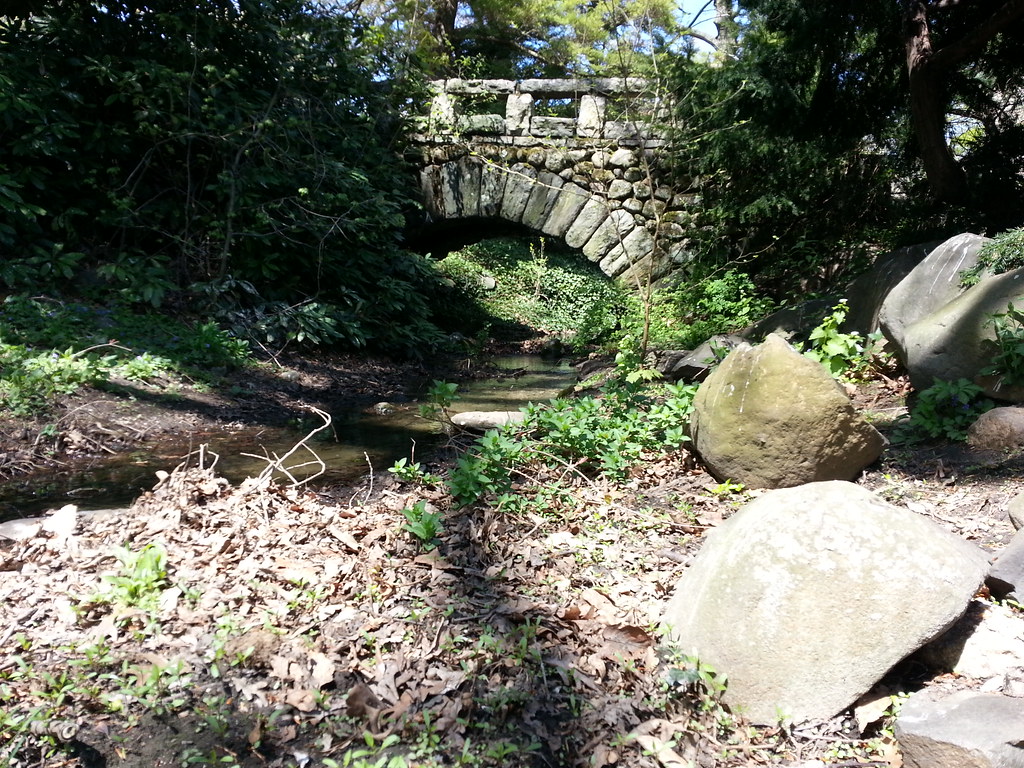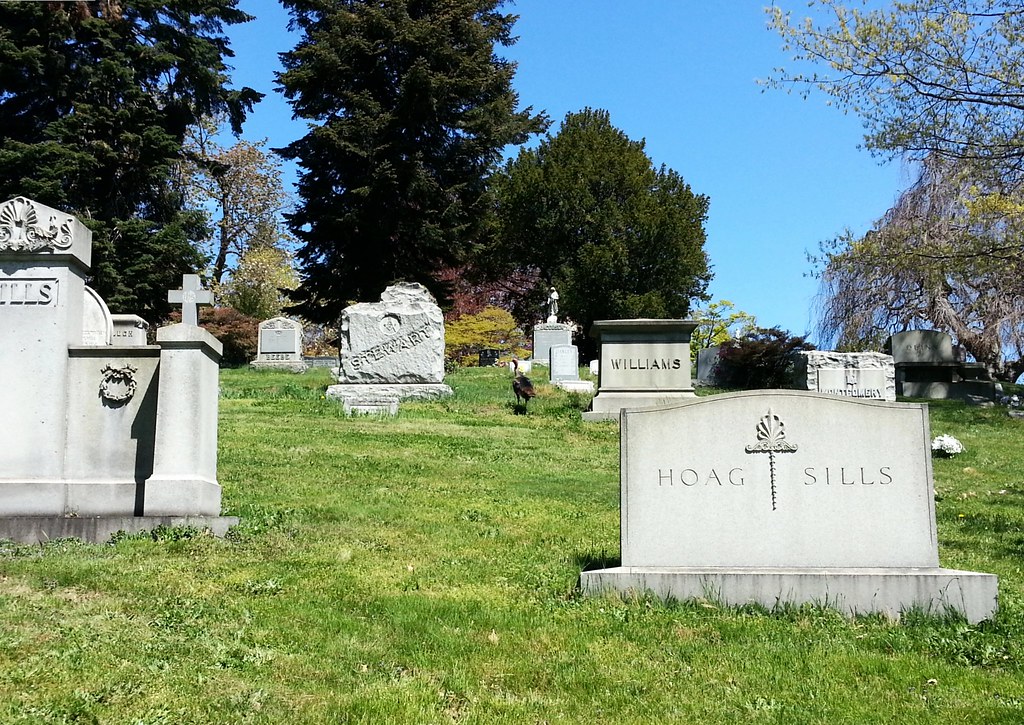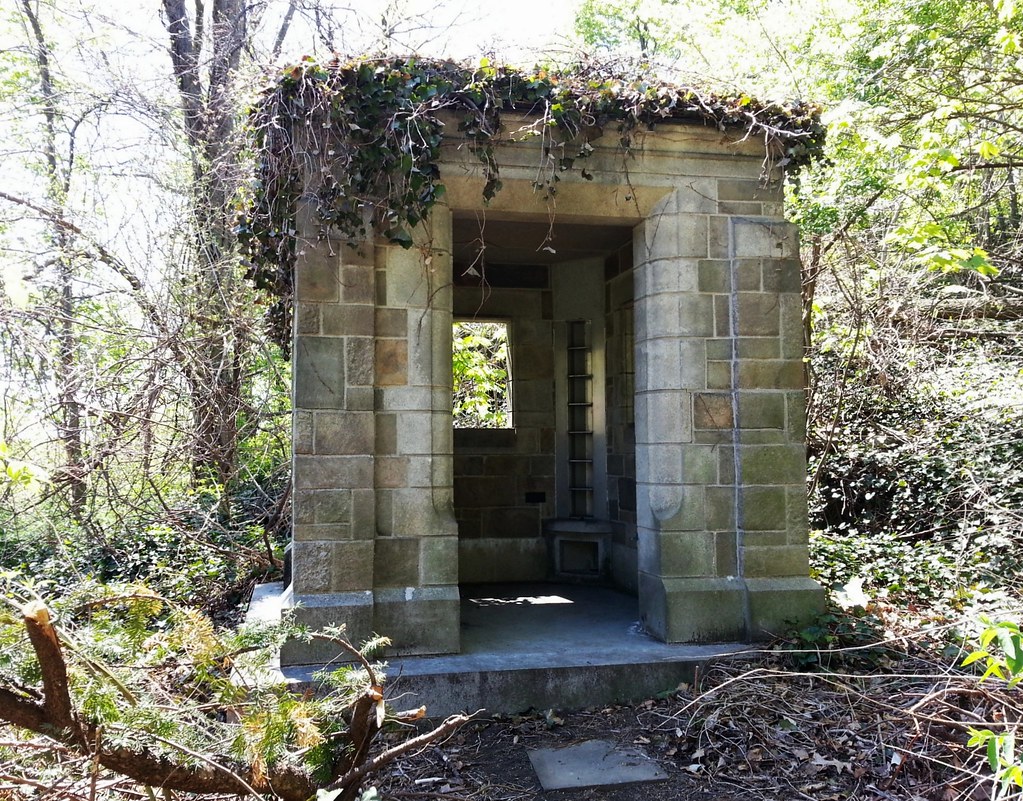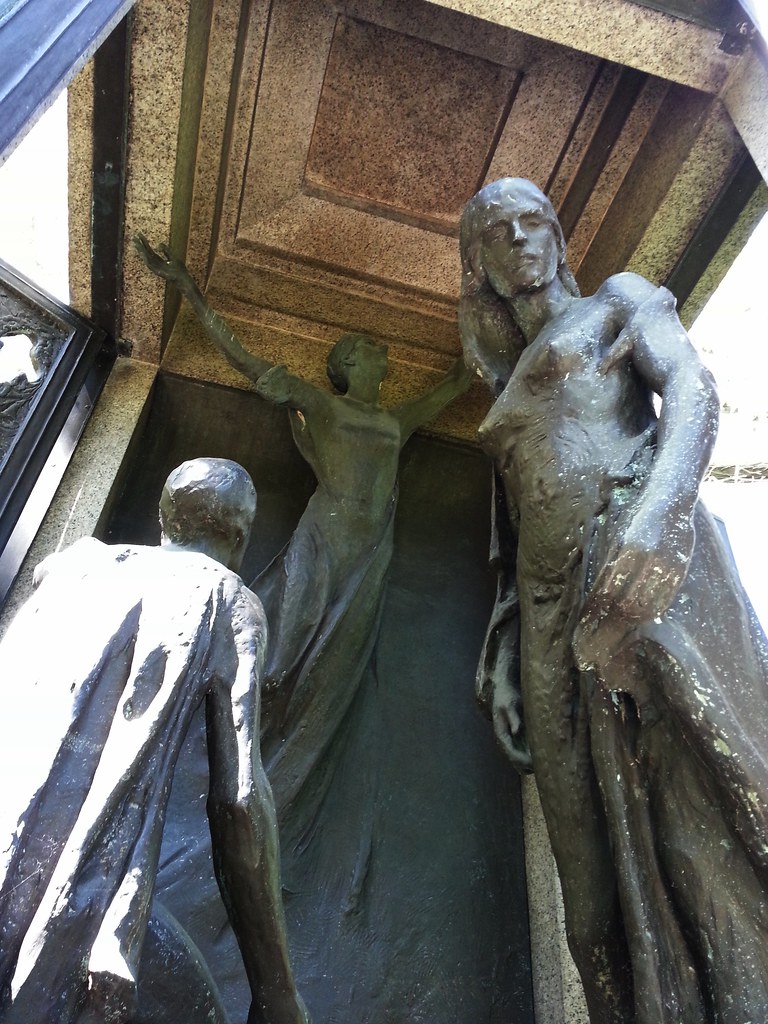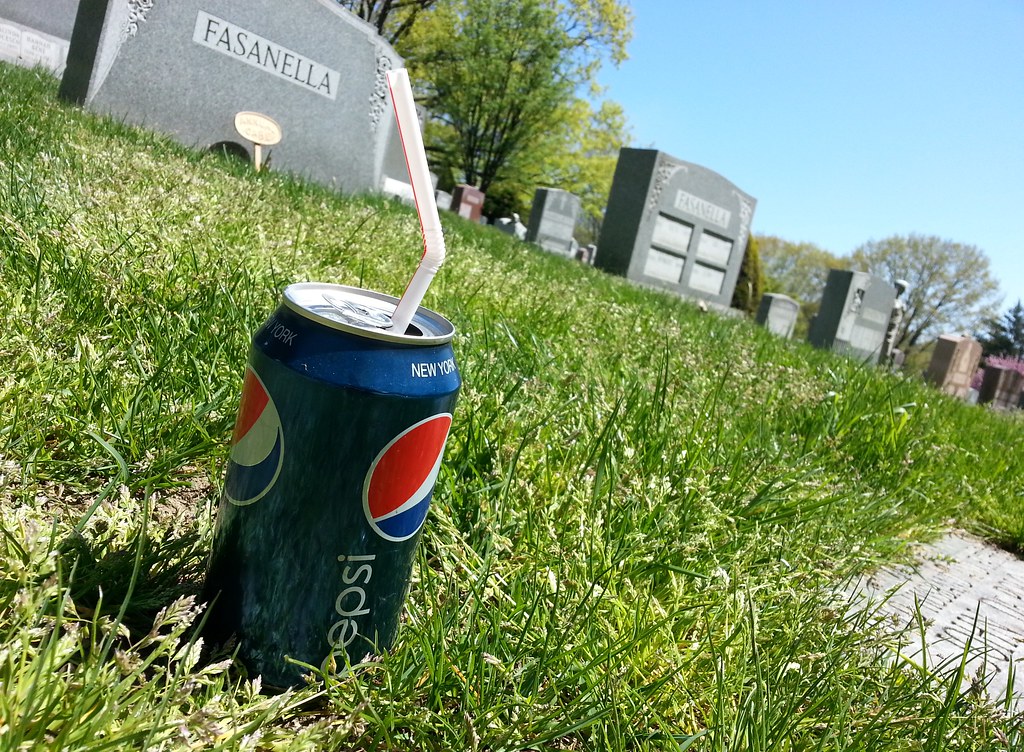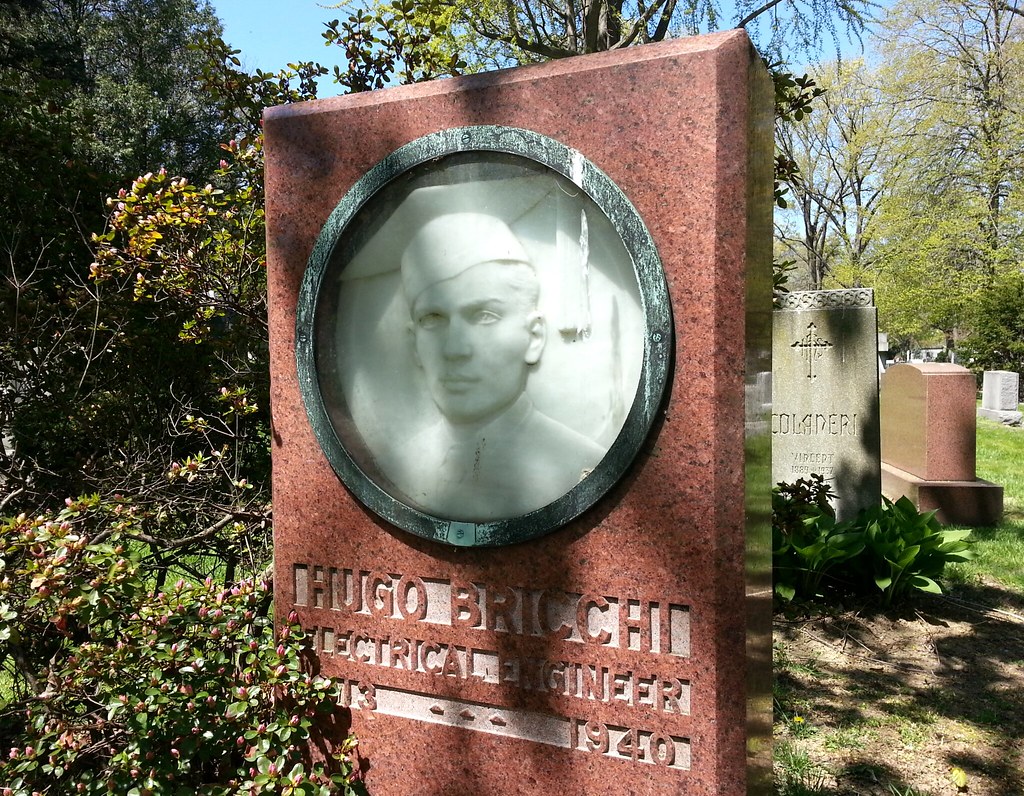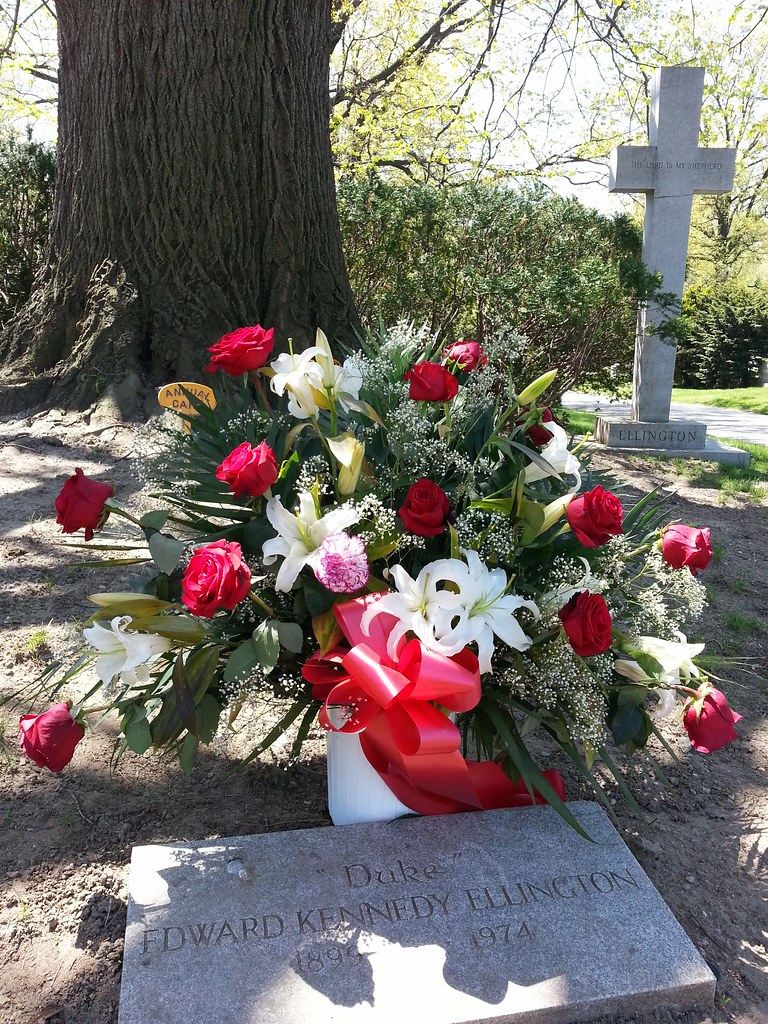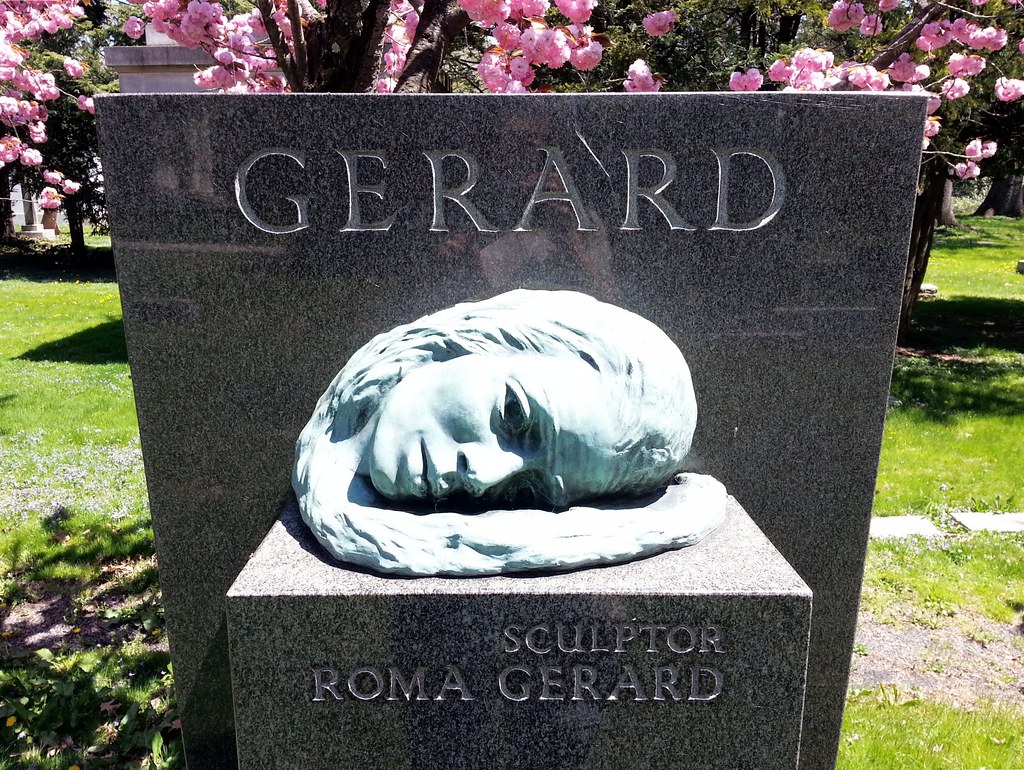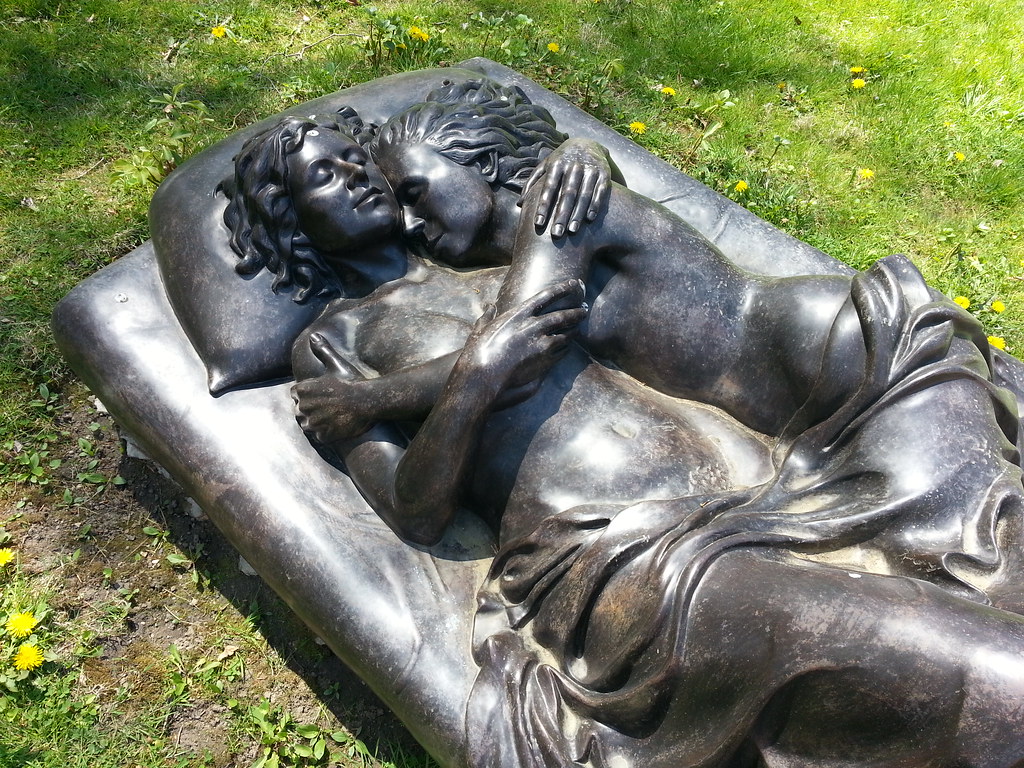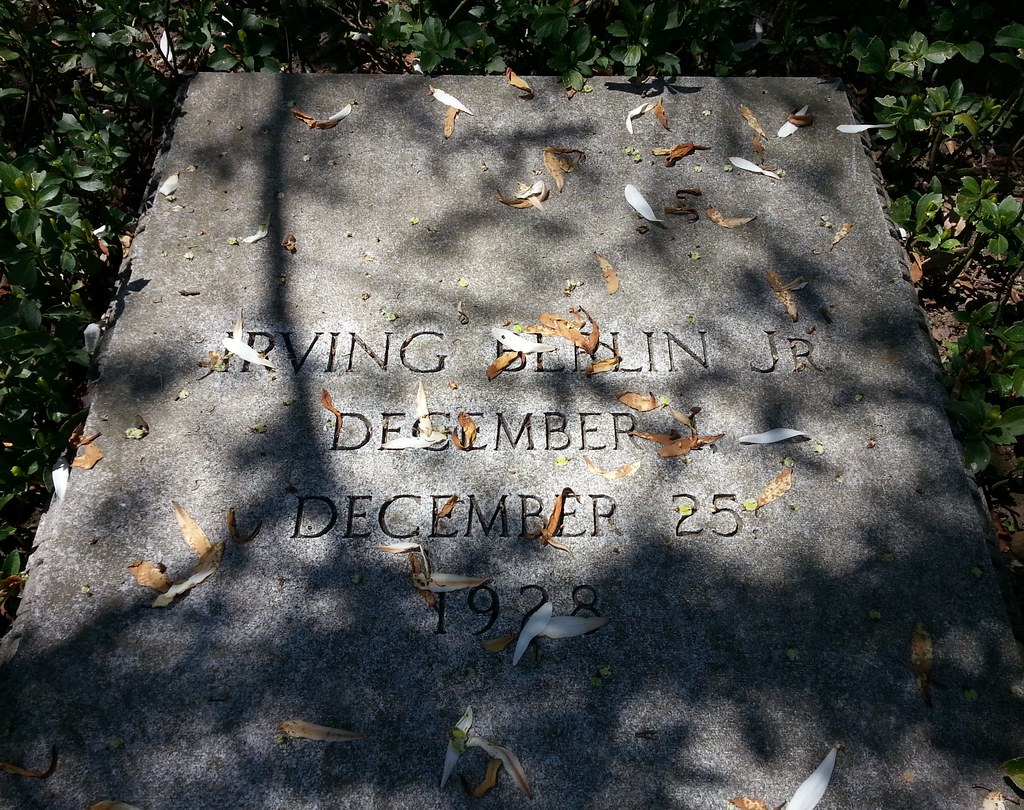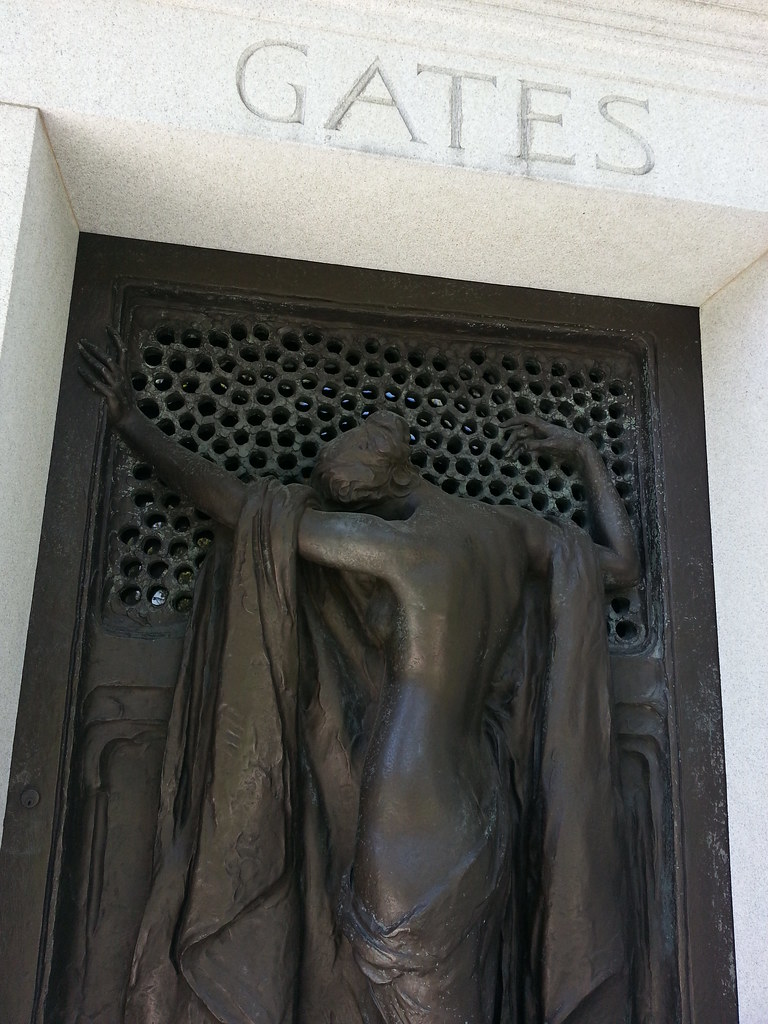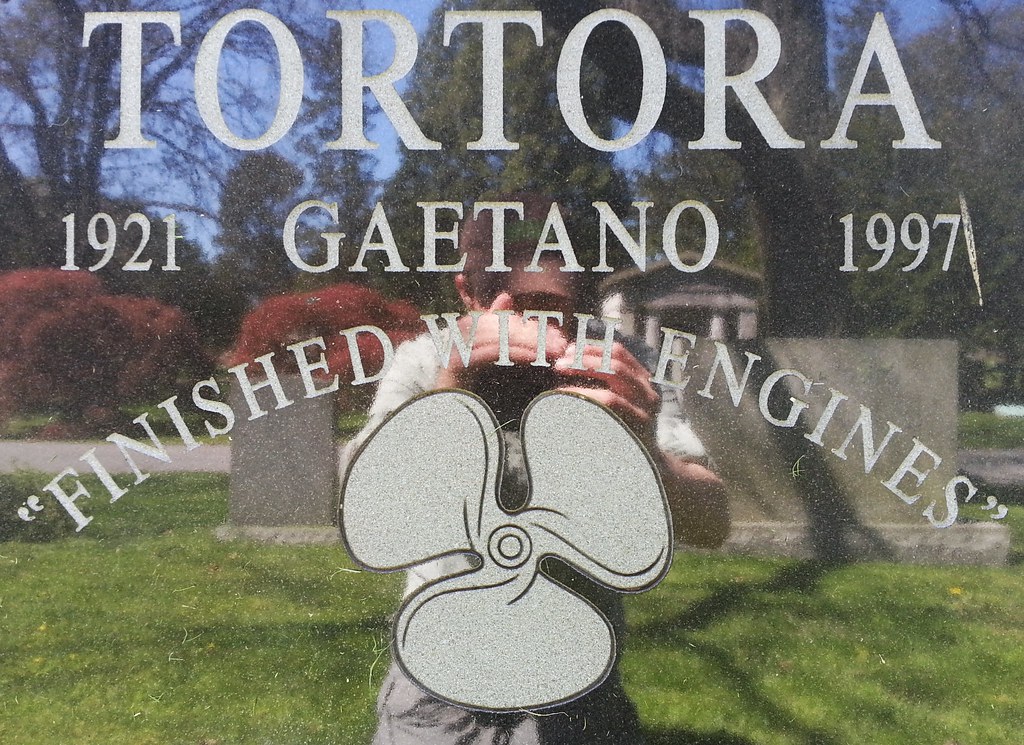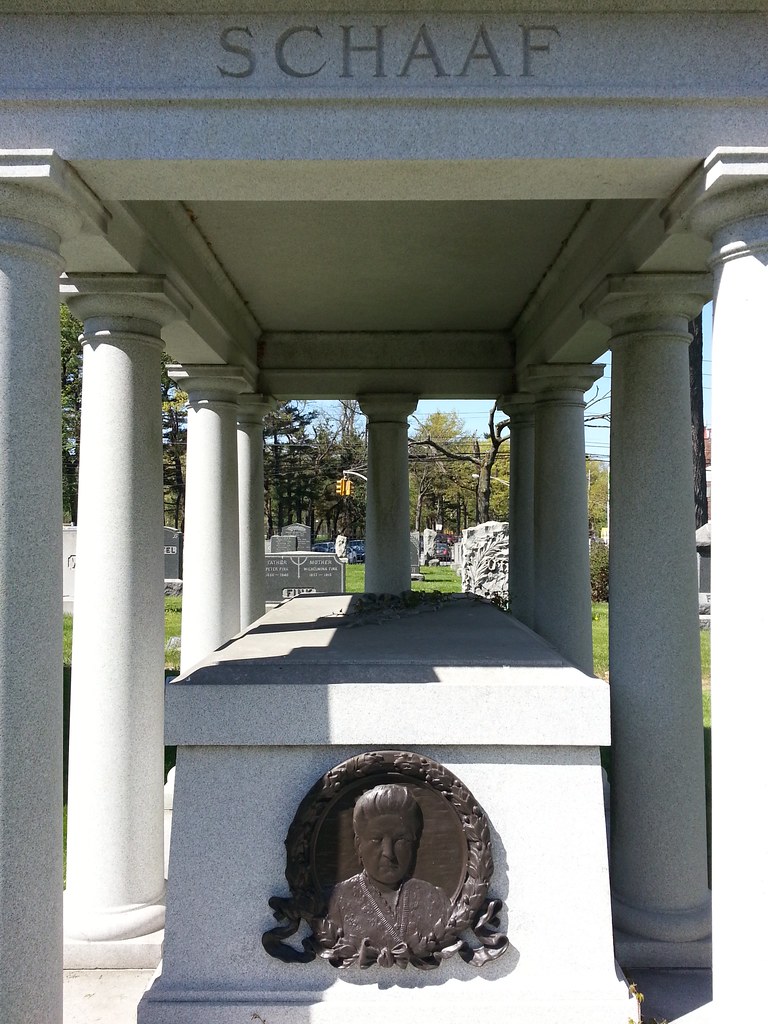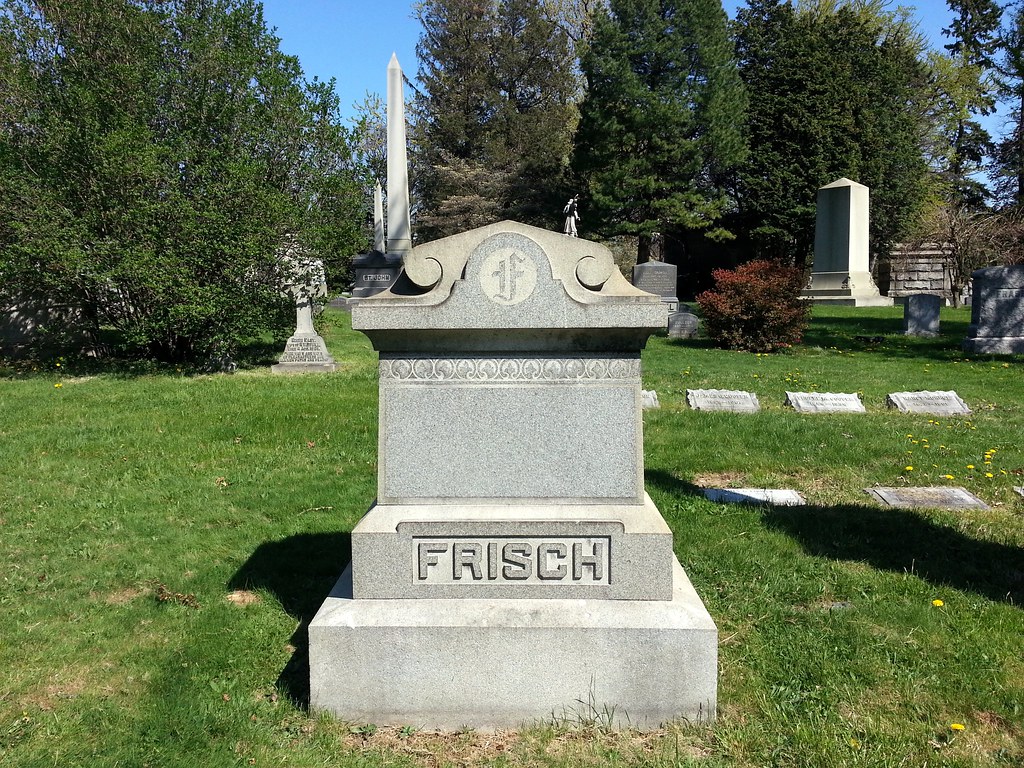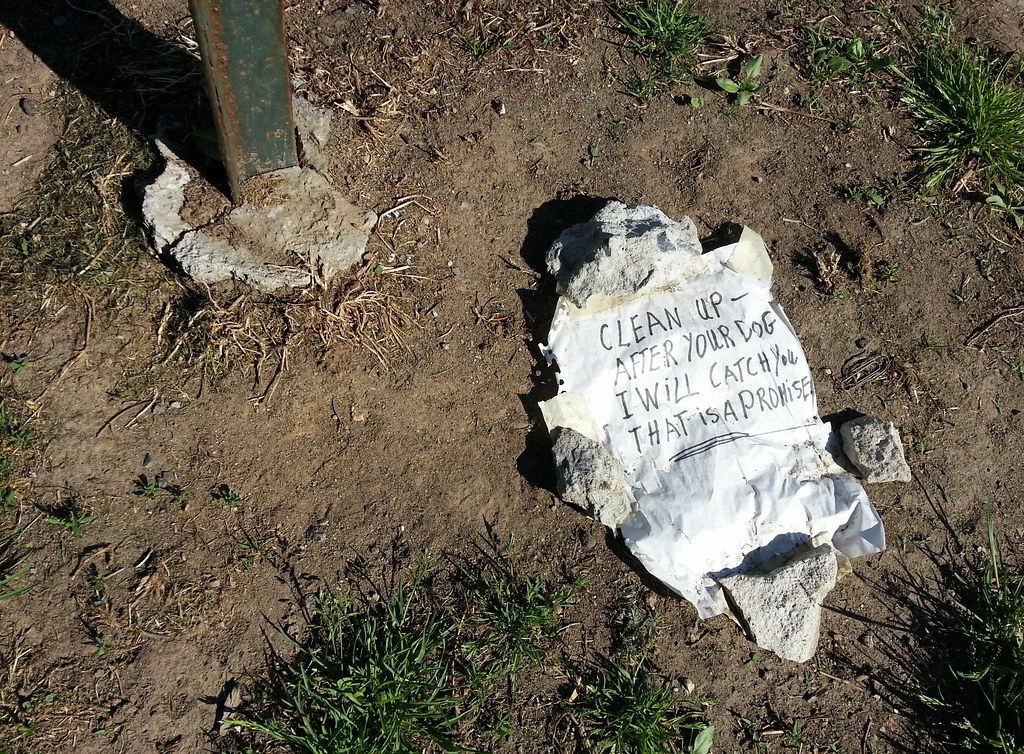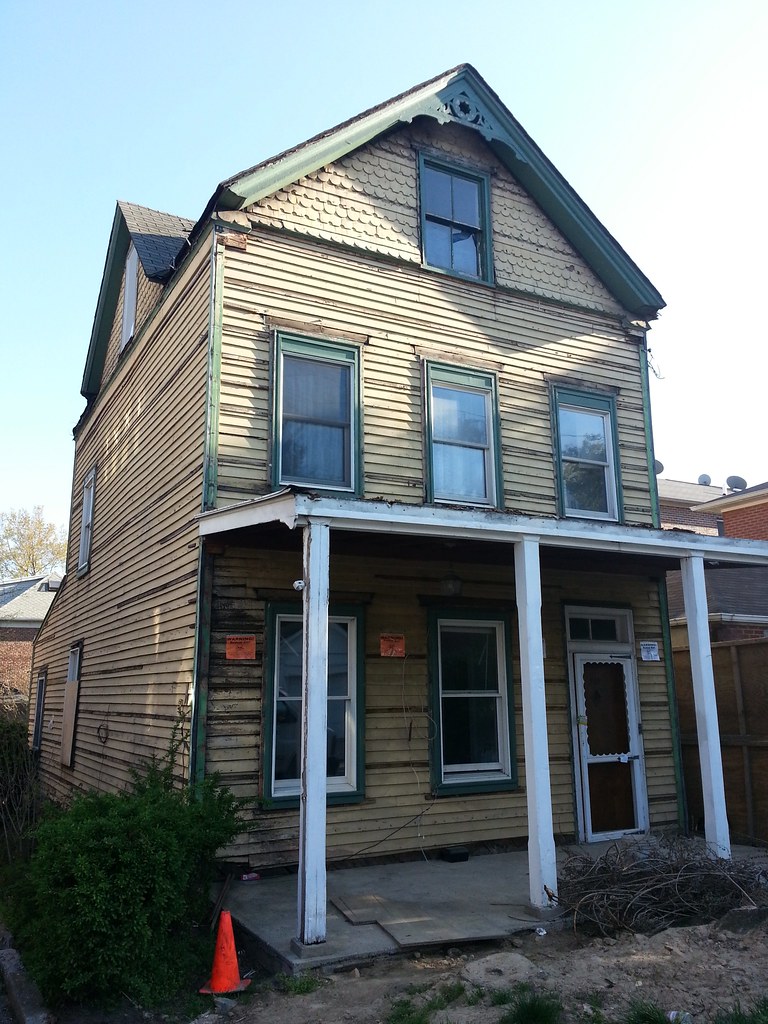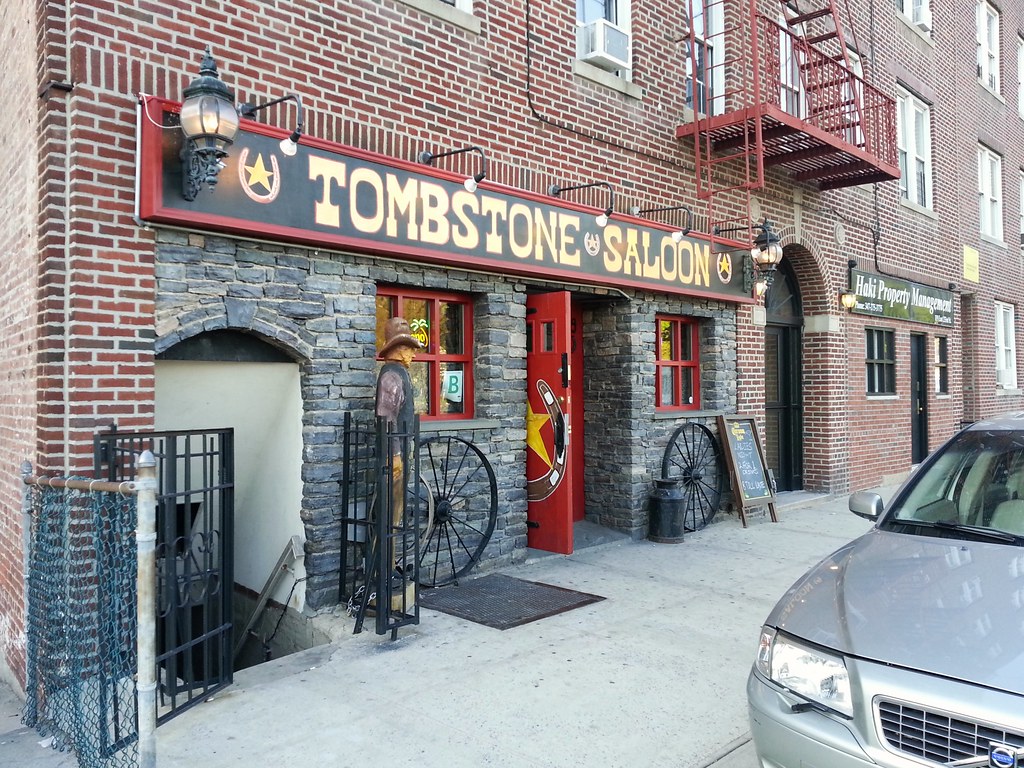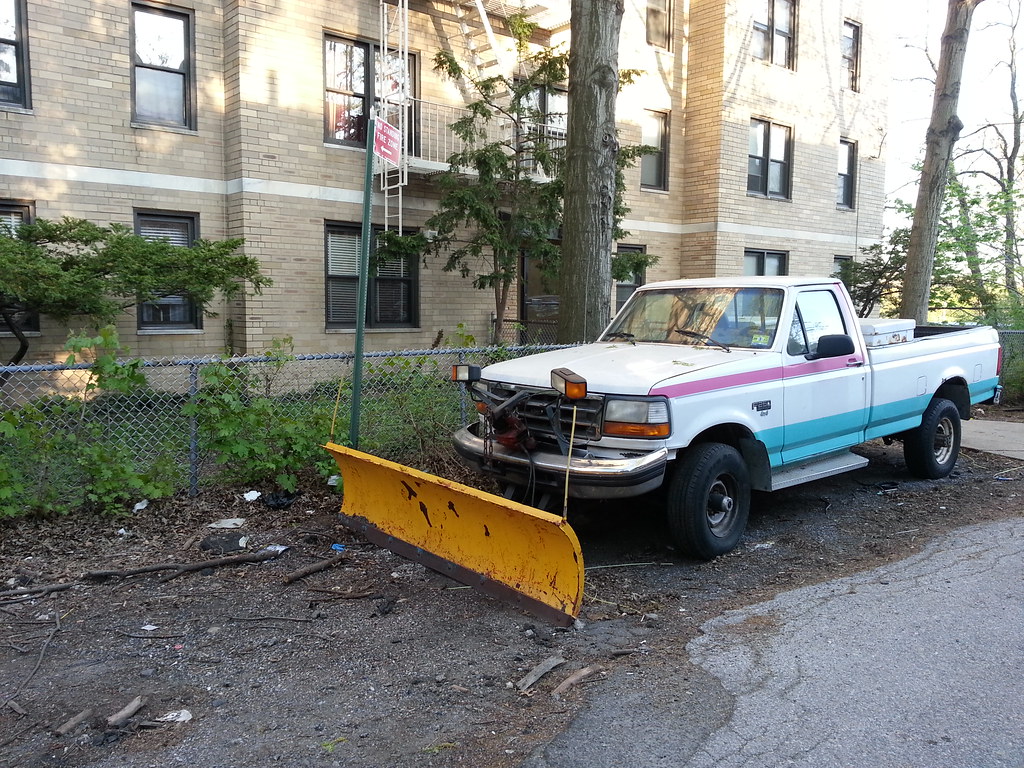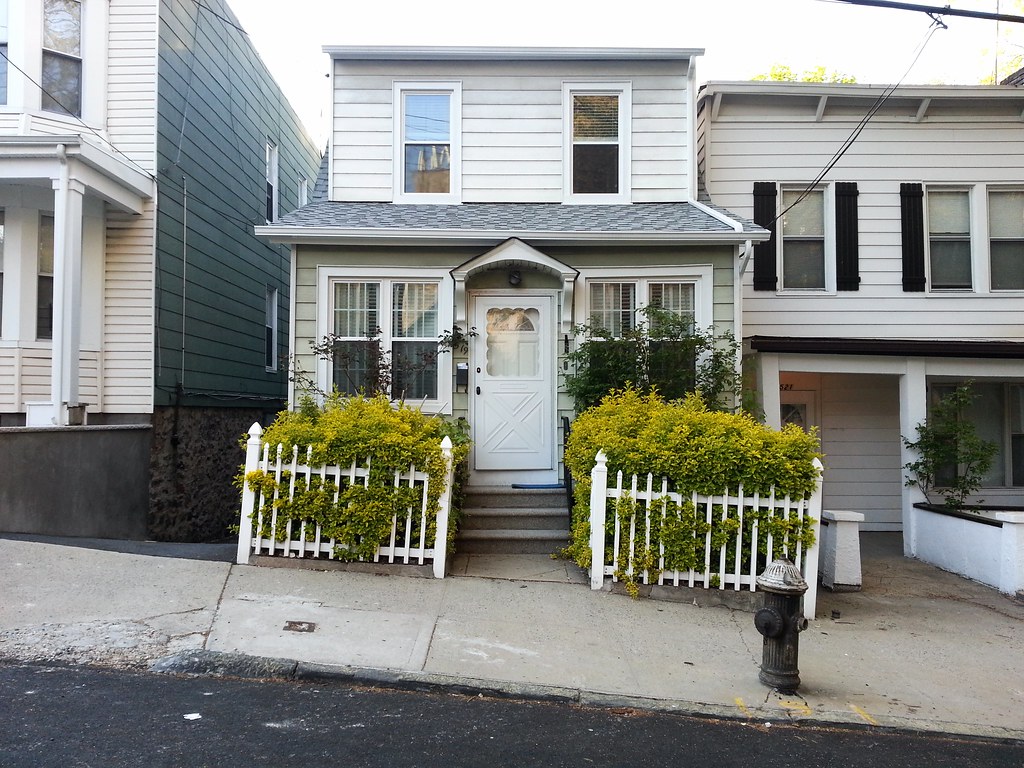

Founded in 1863 in what is now the Bronx, Woodlawn comprises 400 acres of spectacular mausoleums and gorgeous statuary, and quite a few famous dead people as well.
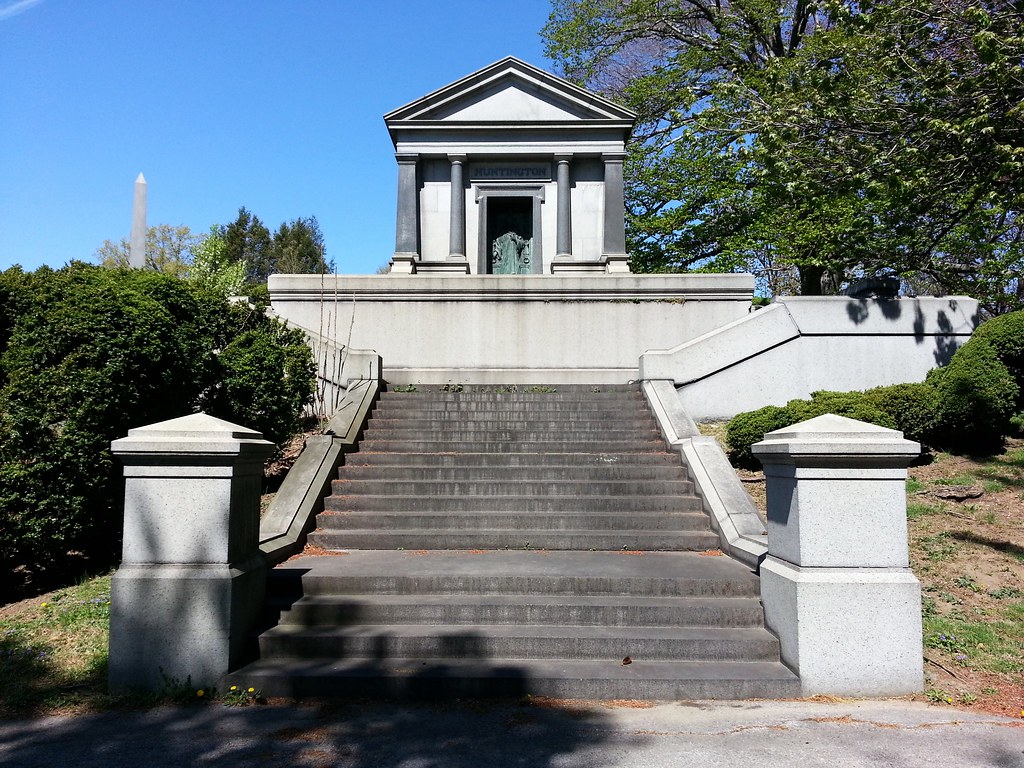
of Collis P. Huntington, the powerful 19th-century railroad magnate (and, as we recently learned, primary benefactor of the Huntington Free Library). About Mr. Huntington's relentless pursuit of his goals, his biographer wrote:
He was that kind of fighter, a slugger lacking in what might be called peripheral moral vision. He saw only what was necessary for success. Huntington did not see qualifying ifs, ands, or buts . . . In the milieu of cutthroat competition, he was unyielding, tireless, ruthless and fertile of stratagems.(Here's a closer look at that intriguing door.)
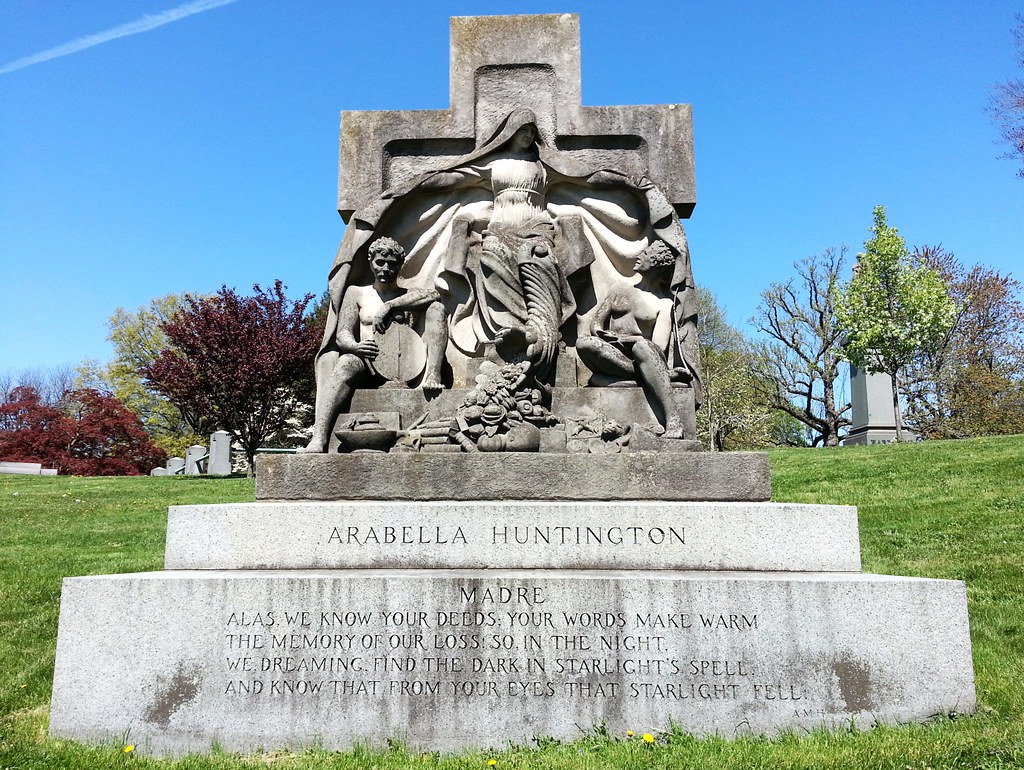
The second wife of Collis P. Huntington (musta been quite a catch), Arabella rose from humble roots in Richmond, Virginia to become "the richest woman in the world" when she inherited a massive chunk of Huntington's fortune upon his death.
She later married her former husband's nephew, Henry E. Huntington, an influential businessman who played an important role in the development of Southern California. Henry and Arabella, under the guidance of a trusted dealer, amassed a tremendous collection of artwork, which they later deeded to the public along with Henry's extensive library and the rest of their estate in San Marino, California, forming the institution now known as the Huntington. Henry and Arabella were buried on the property in a mausoleum designed by John Russell Pope that bears more than a passing resemblance to a later, more well-known creation of his: the Jefferson Memorial. (Arabella's monument here in Woodlawn is merely a cenotaph.)
While researching Mrs. Huntington, I found an NY Times article from 1902 about "an exciting automobile chase" that she was involved in. The "large black machine" in which she was riding blew past a policeman on the streets of Harlem and then
fairly bounded away and it swung at a tremendous pace westward through One Hundred and Twentieth Street into Mount Morris Park West, north along that short, broad thoroughfare to One Hundred and Twenty-fourth Street and on up Fifth Avenue. As it dashed across One Hundred and Twenty-fifth Street it came so near to a collision with a crowded car that spectators held their breath. The course was laid straight up the avenue, but [Officer] Hanley was gradually . . . gaining on the automobile.At a jammed-up 135th Street, Officer Hanley finally caught up to Mrs. Huntington's machine — on his bicycle. He estimated that her driver had been flying up Fifth Avenue at the blazing speed of 17 miles per hour. He dutifully hauled the driver into the station house over Mrs. Huntington's protestations, but she was able to bail him out immediately and continue on her way to her country house in the Bronx.
(Interestingly, Arabella wasn't the only member of the Huntington family to be written up in the Times that year for traveling in a speeding automobile. See "Prince Hatzfeldt Fined For Motor Scorching". Spoiler alert: 30 miles an hour!)
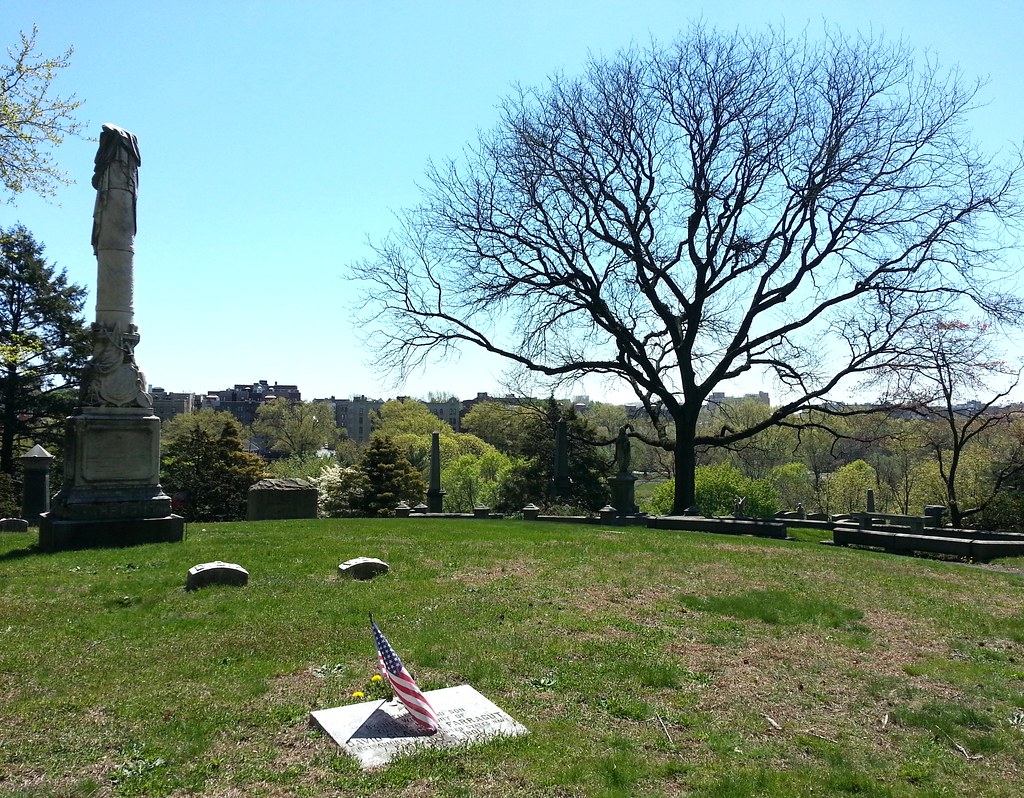
Recently designated a National Historic Landmark (one of 112 in NYC), this is the gravesite of David Farragut, the US Navy's first admiral. (His adoptive brother, David Dixon Porter, was the second.)

Here at Woodlawn, they're still dealing with the aftermath of Hurricane Sandy. Today I saw a crew taking down yet another tree (or maybe just some of its branches). It sounds like Green-Wood was hit the hardest of all the city's cemeteries, though.
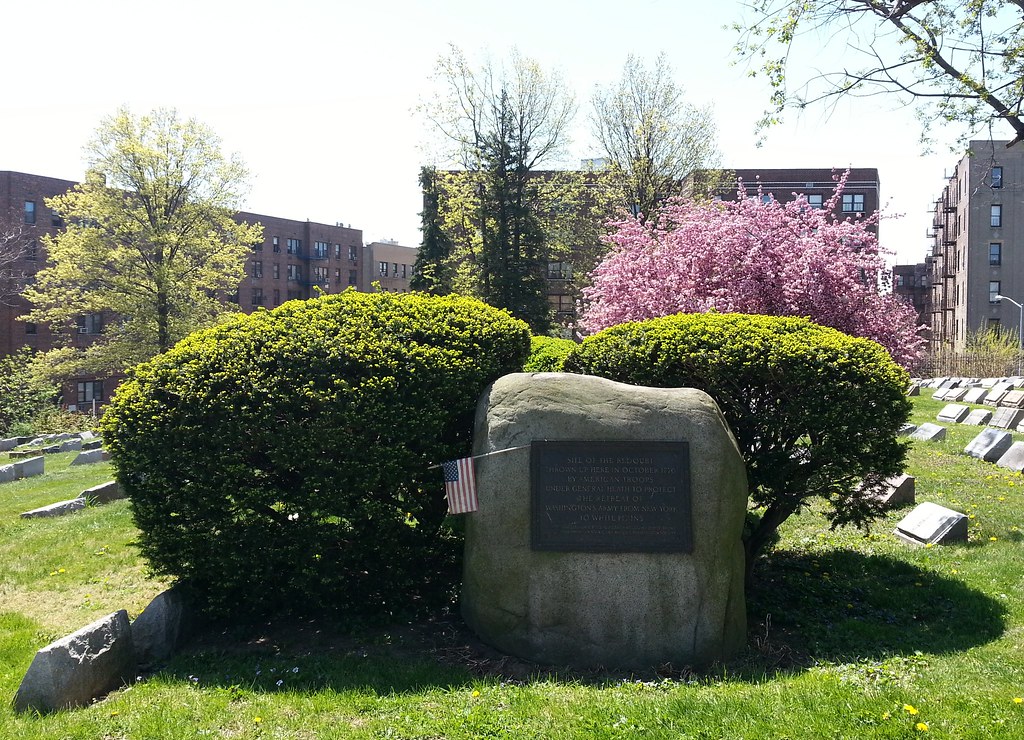
"Site of the redoubt thrown up here in October, 1776 by American troops under General Heath to protect the retreat of Washington's army from New York to White Plains"
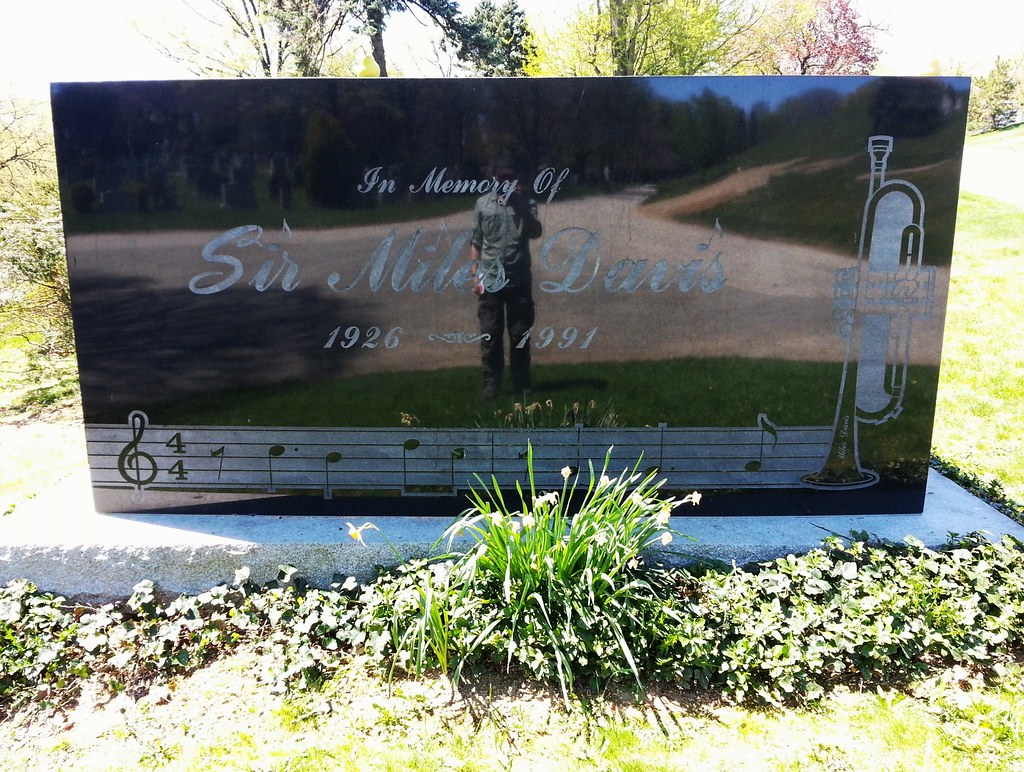
Woodlawn's "jazz corner" (see next post) began to take shape back in 1992, when Miles was laid to rest near the Duke. Here's what the co-author of Davis's autobiography had to say about the two great musicians spending eternity together:
Their spirits are running back and forth . . . They probably got all the worms and everybody doing it. Two people like that together, the energy force of the spirits, the ancestral spirits and their own genius must be too heavy. There must be some heavy stuff.In case you were wondering, and even if you weren't, those are the first two measures of "Solar" engraved on the stone. While searching for a recording of that tune, I found Davis's beautiful rendition of a song that has been a favorite of mine ever since I walked through Wisconsin.
(For the record, this is not the only Miles Davis monument that can be found in the Bronx.)
(Also, for the record, someone had left Miles an offering of two pears on top of his headstone.)

Illinois Jacquet. Also buried here at Woodlawn's "jazz corner" are Lionel Hampton and Max Roach, and the graves of many other jazz greats, such as W.C. Handy and Coleman Hawkins, can be found scattered throughout the cemetery as well. Roach's headstone is inscribed with the last of the 10 free-form haikus that Sonia Sanchez composed for the legendary drummer after his death:
your hands
shimmering on the
legs of rain

Celia Cruz's mausoleum, which she shares with her late husband, was designed to accommodate her loyal following. There are clear windows on the sides, allowing people to peer in, and "someone comes in on a regular basis, cleans it out and changes the photos so there’s always something for the fans to see."
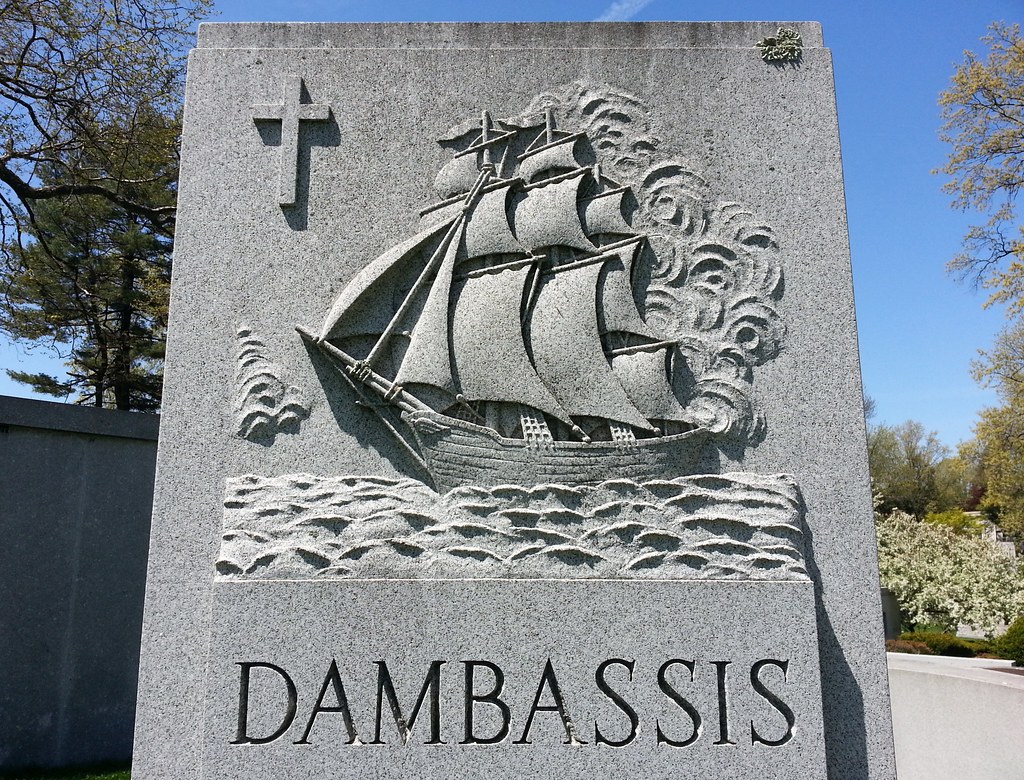
This stone lists the family's patriarch as a "Captain Demosthenes"; perhaps he is the wealthy Greek shipper of the same name mentioned in this 1968 column by Suzy Knickerbocker about that summer's coming-out parties for debutantes in Newport and the Hamptons.
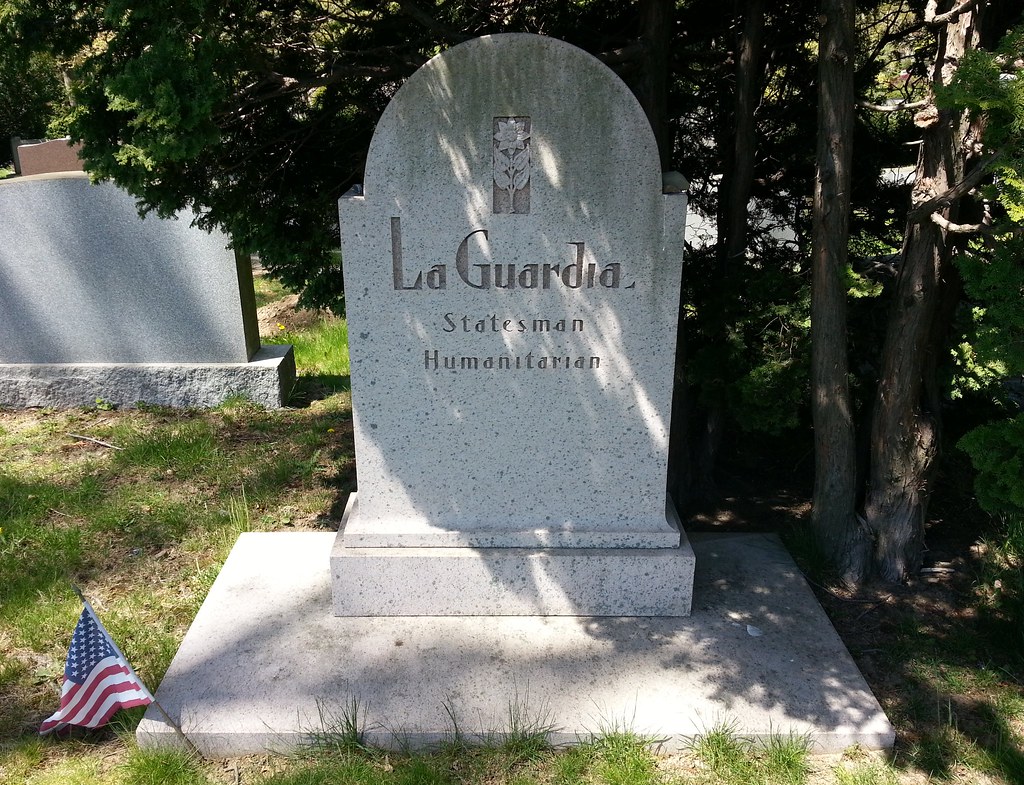
From Mayor La Guardia's 1947 NY Times obituary:
[He] was only about 5 feet 2 inches in height, a rotund little man with a swarthy skin and a belligerent independence that often verged on irascibility. A forelock of black hair invited comparison with Napoleon. His voice was high, and in debate often became a screech. . . .
A crusader all his life in the interests of the underprivileged and the oppressed, the "Little Flower" was a clever showman whose campaigns were always spectacular and whose battles against corruption and special privileges were usually successful. His enemies sometimes called him a demagogue, but to his followers he was a latter-day St. George, bent on slaying the Tammany Tiger rather than the fabled dragon.

About this stone rest the remains of 417 among them early settlers and soldiers of the colonial and national wars, interred 1664-1908 in Nagel Cemetery, West 212th Street Manhattan, the site of which was covered by a vast public improvement [the 207th Street subway yard]. Reinterred here 1926-1927 by the City of New York.
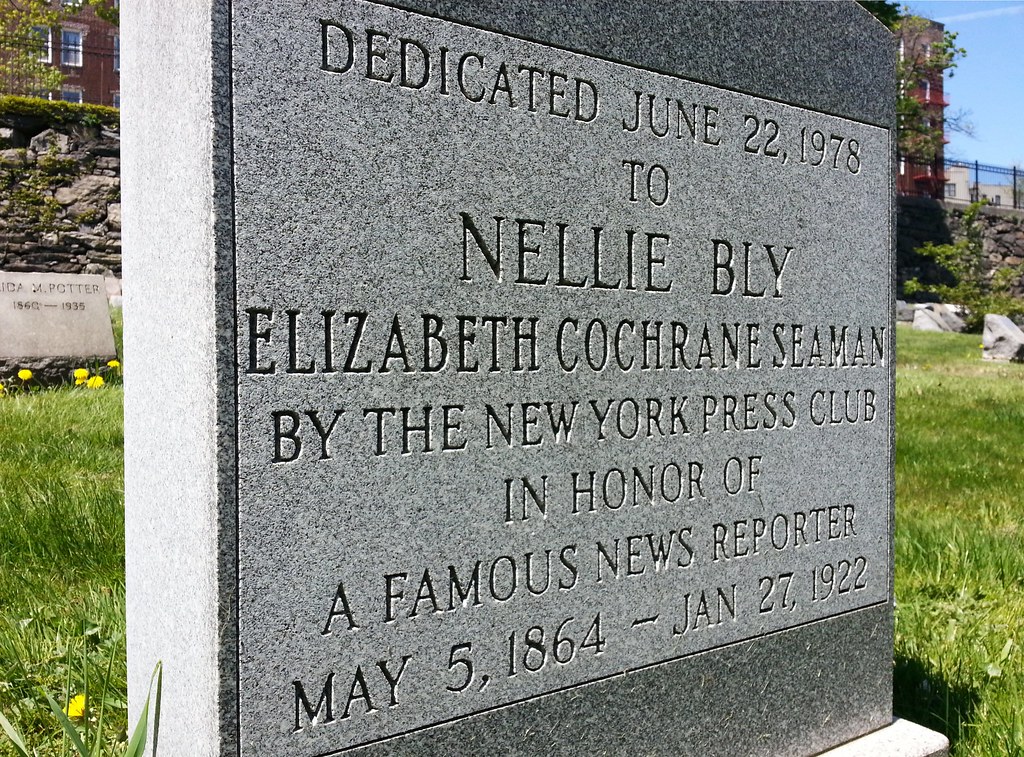
Nellie Bly "remains notable for two feats: a record-breaking trip around the world in emulation of Jules Verne's character Phileas Fogg, and an exposé in which she faked insanity to study a mental institution from within."
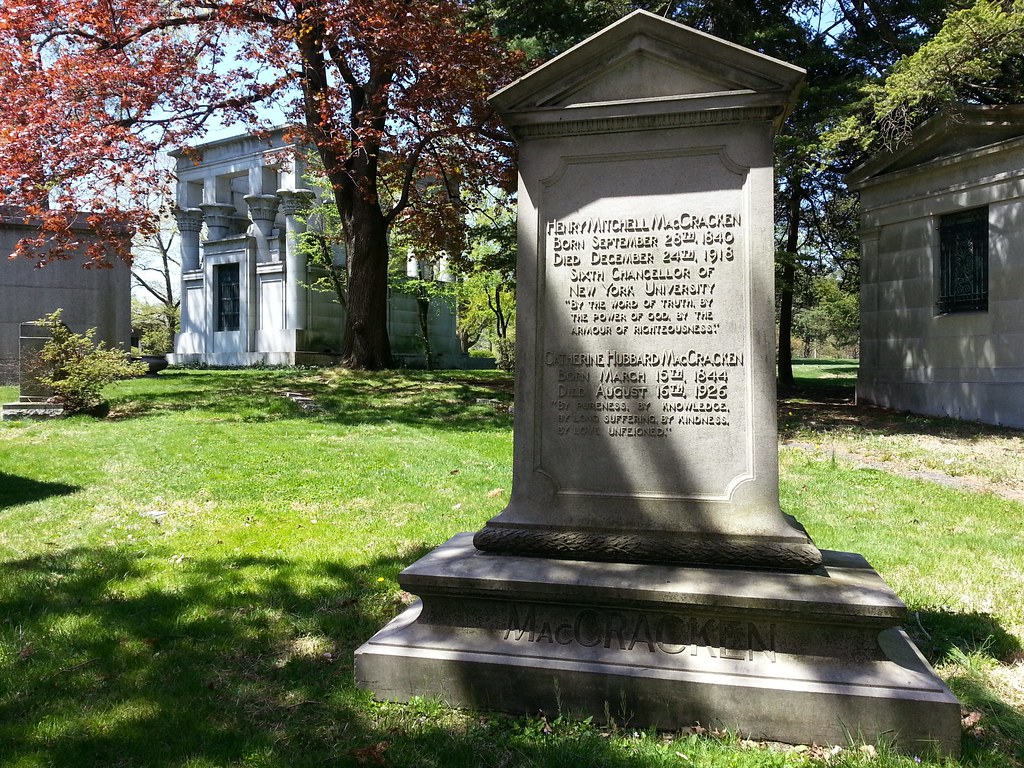
As chancellor of NYU, he was the driving force behind the creation of the Hall of Fame for Great Americans, now one of the city's most wonderful forgotten treasures. But far more importantly, he's the first character we've come across whose beard has a fighting chance of besting Peter Cooper's.

This prominent banker's remains are entombed inside a replica of Trajan's Kiosk.
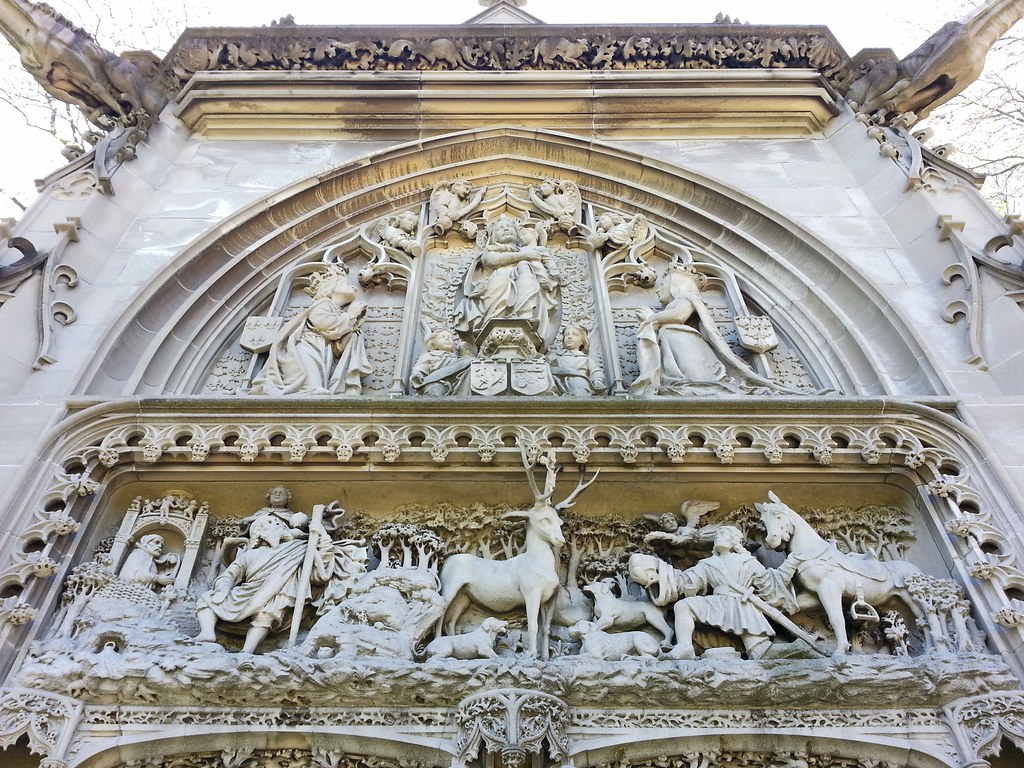
This replica of the Château d'Amboise's chapel of St. Hubert (where Leonardo da Vinci's remains are supposedly interred) is the final resting place of Alva and Oliver Belmont.
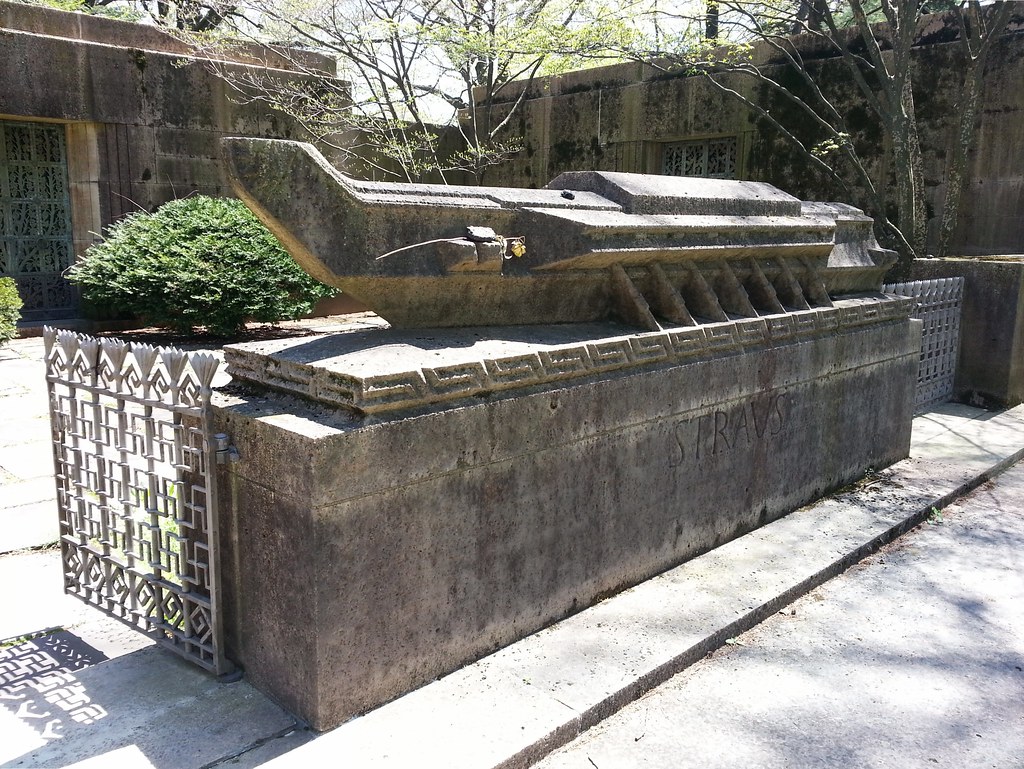
This is the tomb of Isidor Straus, a former congressman and co-owner of Macy's, and the cenotaph of his wife Ida. The couple died aboard the Titanic after Isidor passed up a lifeboat seat, seeing that there were still women and children on the ship, and Ida refused to leave his side. Isidor's body was later recovered, but Ida's was never found. The other side of the monument is inscribed with a line from the Song of Songs: "Many waters cannot quench love, neither can the floods drown it".
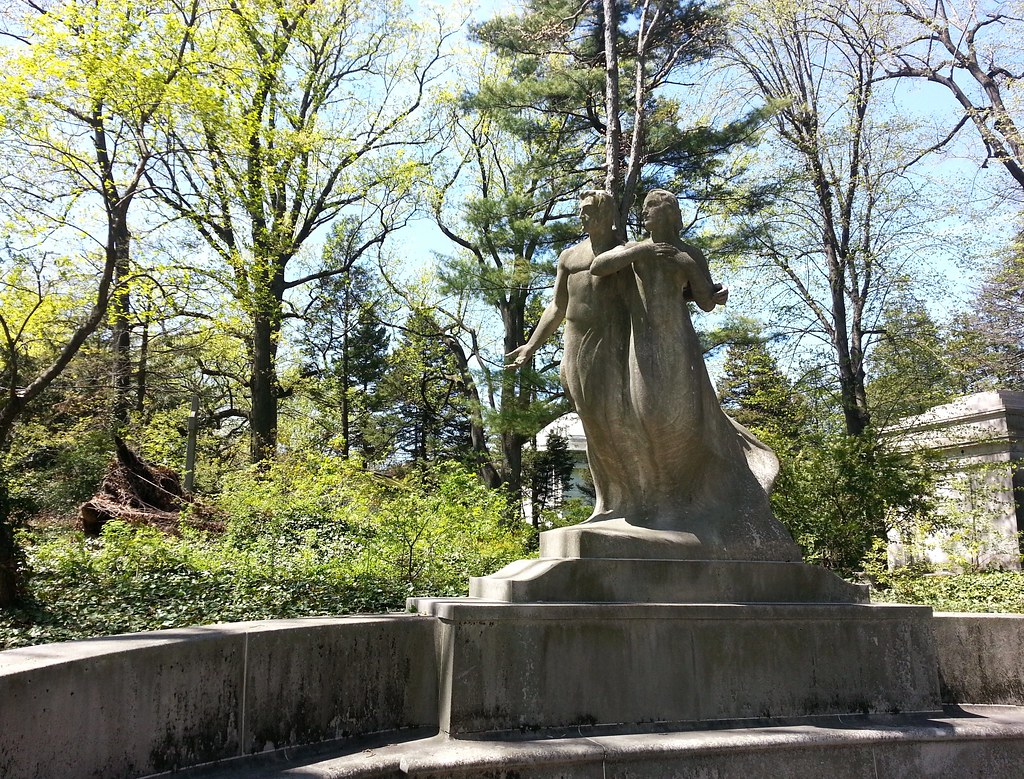
This unique monument was commissioned by William H. Bliss and his wife, Anna, sometime around 1913, a couple of decades before their deaths. An 1919 architectural review of the "William H. Bliss memorial" calls it "a significant contribution to the art of funereal commemorative monumental design" and says its "design gives evidence of thought and of a serious purpose and it establishes new precedents in this field of design."
If you search online, you'll find a multitude of sites referring to this monument as the "Annie Bliss Titanic Memorial" (or some variation thereof) and stating that Mrs. Bliss dedicated it to all those lost in the tragedy. While the monument does have a nautical theme — for instance, the Wordsworth line "Our souls have sight of that immortal sea which brought us hither" is carved into the exedra — and was designed just a year after the Titanic sank, I didn't see any text on it referencing the disaster (although I wasn't looking too closely at the time), and I can't find any mention of Mrs. Bliss's supposed dedication in the historical record.
Perhaps its location directly across from the Straus tomb (see previous post), combined with the fact that Woodlawn is said to have more "Titanic people" than any other cemetery in the US, has helped fuel this seemingly apocryphal claim. And it can't hurt that the two sculpted characters look like Jack and Rose from the movie Titanic — at least to the eyes of some younger cemetery visitors. (I also feel the need to note that the NY Times blog post to which I've now linked twice in this paragraph refers to Mrs. Bliss as an "heiress to a laxative fortune".)

This sculpture by Patricia Cronin, depicting her and her wife, Deborah Kass, embracing in bed, will one day mark the couple's graves here at Woodlawn. When the original marble version of this work was installed in 2002, same-sex marriage was not legal anywhere in the United States. But less than nine years later, on a July day in 2011, Ms. Cronin and Ms. Kass found themselves tying the knot at the Marriage Bureau in Manhattan. "Making this was a little prophetic", said Ms. Cronin, referring to the memorial. "I never thought the law would change this quickly." (She replaced the marble monument with this bronze version a couple of months after the nuptials.)
You can see more photos of the sculpture here, and read an interview with the artist here.
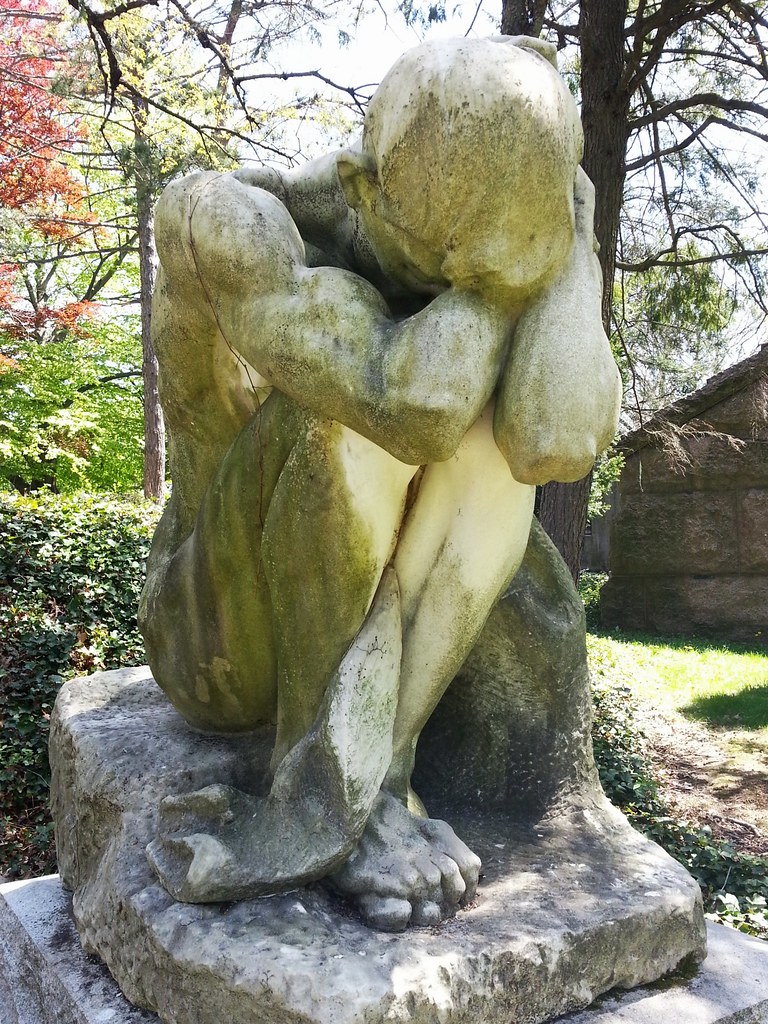
IN MEMORY OF
OUR ONLY BELOVED SON
ENSIGN NATHAN Q. F. PICCIRILLI
WHO MADE THE SUPREME SACRIFICE
FOR HIS COUNTRY AT THE BATTLE
OF ORMAC BAY, PHILIPPINE ISLANDS
ON DECEMBER 7, 1944
(Sculpted by his uncle)

This is what Jerome Kern had to say about the Jewish composer of "White Christmas", the best-selling recording of all time, who cranked out an endless stream of hits over the decades: "Irving Berlin has no place in American music. He is American music."
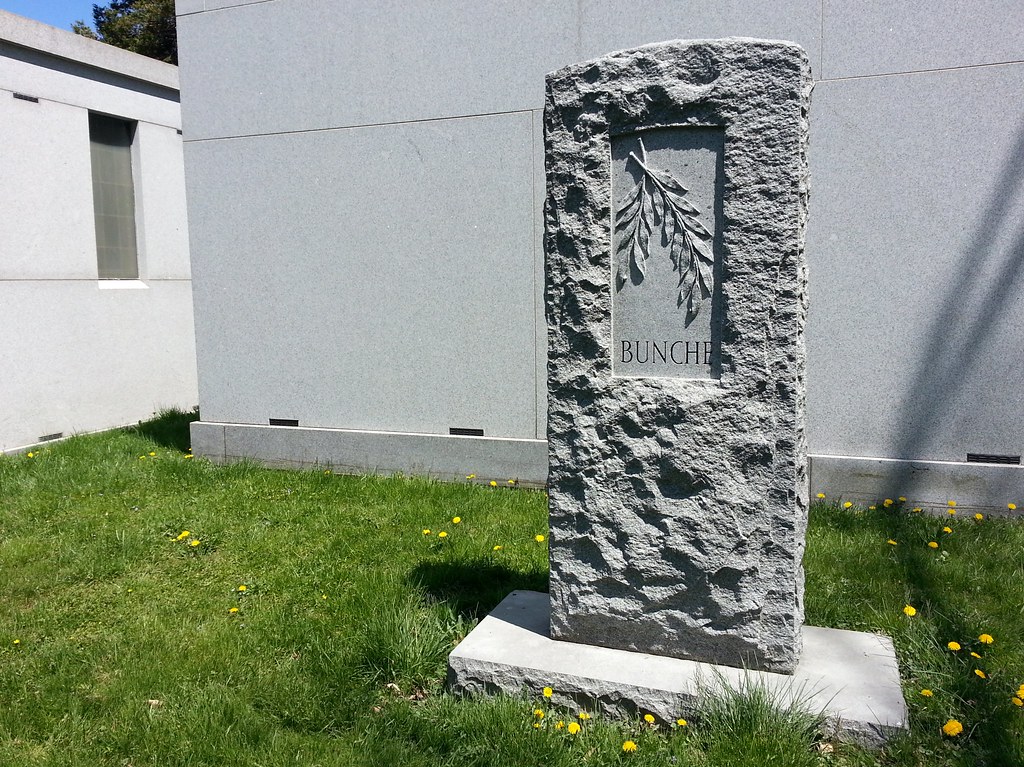
Olive branches are a fitting symbol for the life of this longtime UN diplomat who became, in 1950, the first African-American winner of the Nobel Peace Prize.
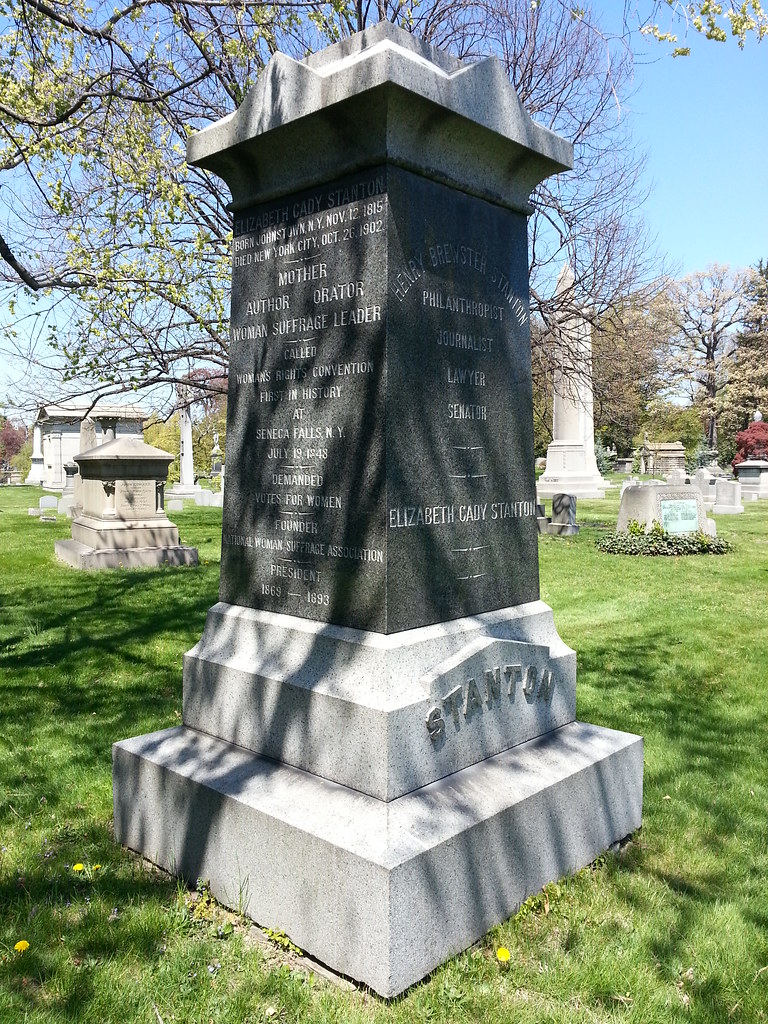
19th-century pioneer of the women's rights movement.
I didn't know it at the time, but not too far away is the grave of George Spencer Millet, who died a bizarre and tragic death on February 15, 1909, the day he turned 15 years old. According to his headstone:
LOST LIFE BY STAB IN FALLING ON
INK ERASER, EVADING SIX YOUNG
WOMEN TRYING TO GIVE HIM
BIRTHDAY KISSES IN OFFICE
METROPOLITAN LIFE BUILDING

The eponymous founder of the prestigious prizes for excellence in American journalism was also the father of yellow journalism, making him the grandfather, I guess, of the NY Post and the Daily News and the rest of today's trashy tabloid rags.
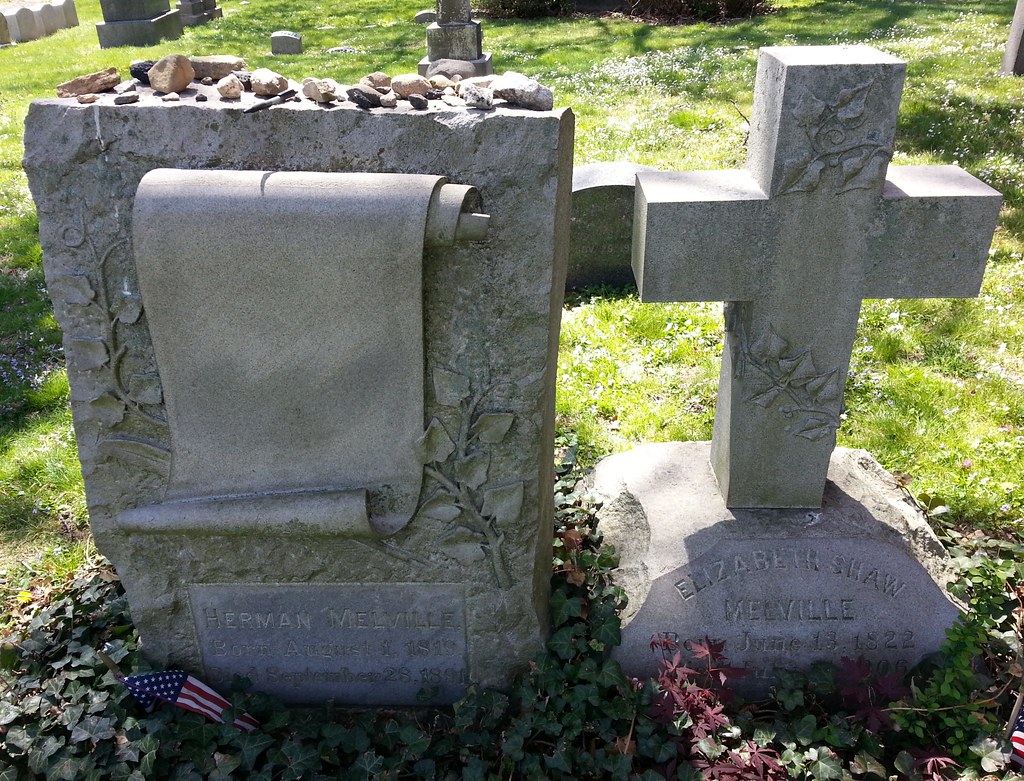
On previous visits to Mr. Melville's grave, I've found much more colorful and appropriate tokens left on his tombstone, including a profusion of pens and a canister of La Baleine Sea Salt. (The one pen in the photo above is mine.)
After the wealthy stockbroker John H. Harbeck died at the Plaza Hotel after a short illness in 1910, his wife, Kate, set about to build the most expensive and impressive mausoleum at Woodlawn Cemetery. The architect Thomas E. Blake designed a 90-foot-tall marble octagon with a steeple, heavy bronze doors, Tiffany windows and a pipe organ. The mausoleum was built by Guastavino in 1918. Kate was buried in the mausoleum in 1930 after dying in freakish revolving door accident on New Year's Eve at the Plaza Hotel.A few other miscellaneous items:
• John and Kate were apparently doting pet owners who were ridiculed by their neighbors in Boulder, Colorado (where they had a summer home) for "holding expensive and elaborate funerals" for their dogs.
• After meeting Kate, John went through some messy divorce proceedings with his wife, Caroline, that centered around determining whether Caroline was, in fact, his wife, legally speaking. The NY Times covered the trial pretty heavily, but also evinced some disdain for those captivated by the scandalous affair: "A great number of persons with nothing else to do crowded the court-room . . . yesterday morning, and many more stood in a line for hours waiting for an opportunity to enter".
• In researching the Harbecks, I stumbled upon yet another example of how much better journalism was a hundred years ago. From a 1906 report in the NY Times: "LOST — A CEMENT BARREL. It Had a High Old Time Before It Invaded the Subway". The piece goes on to offer the reader some sage, hard-earned words of wisdom: "an old barrel that is out for a good time and does not care a hoop, any way, is a difficult thing to tackle in a stiff breeze."
• While we're on the subject, you should also read this great NY Times article from 1882 that I discovered a few weeks ago:
Some Italian lunatic residing in Turin has for months past been indulging in the monomania of writing and sending enormous quantities of letters to persons residing in this City . . . The recipients, regarding the matter as an oversight on the part of some foreign or traveling friend, pay the postage and open the letters only to find them filled with balderdash and senseless twaddle in Italian, with a faulty English translation appended, the nonsense being usually addressed "to the noble and illustrious reader," and the writer subscribing himself as "The Emperor of the World, Monarch of the Universe," &c.
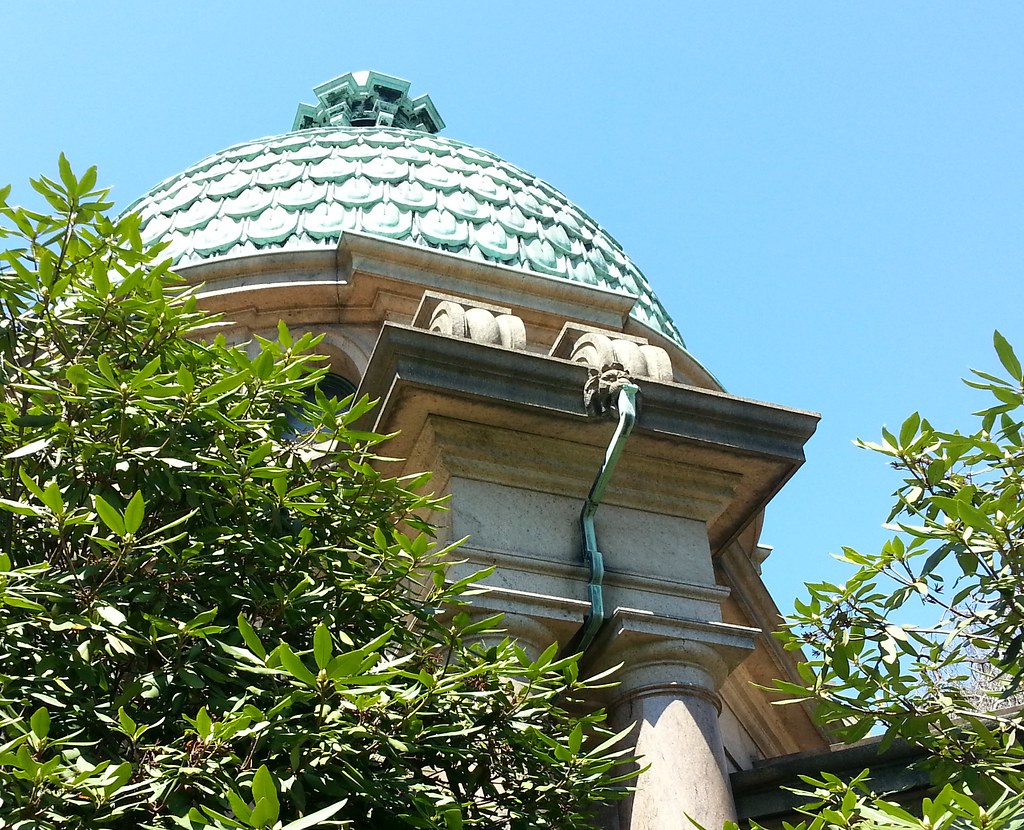
The mausoleum of Herman O. Armour, co-founder of Armour & Company, the meatpacking giant
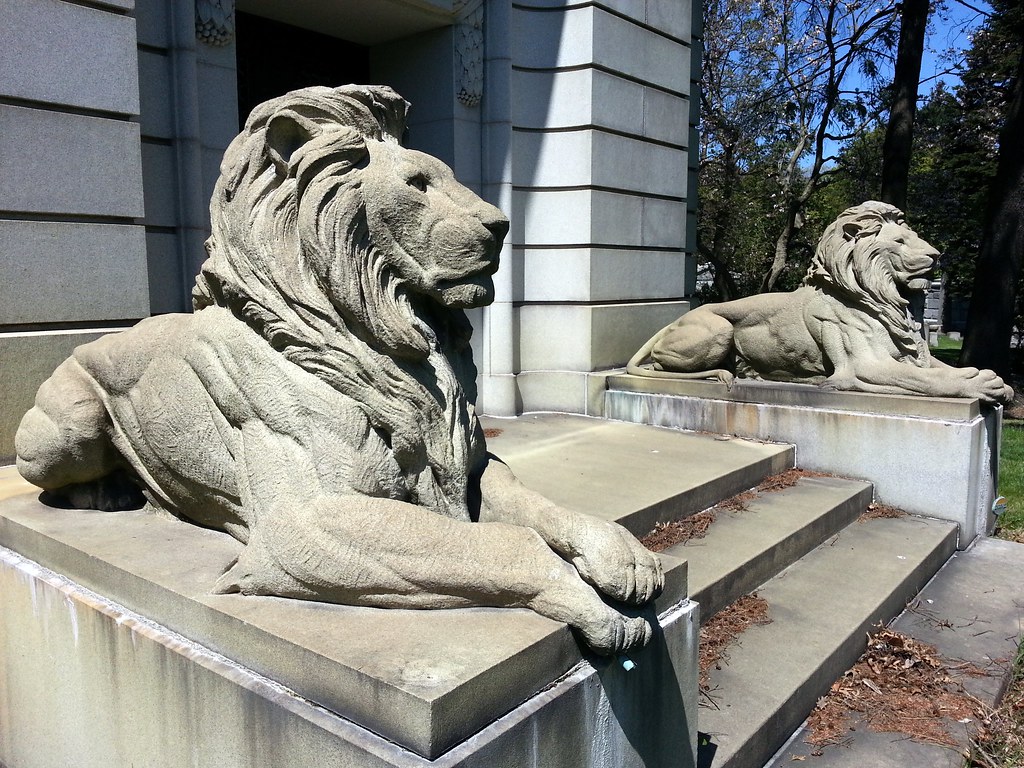
Guarding the tomb of George Ehret, the "King of Beer Corners"
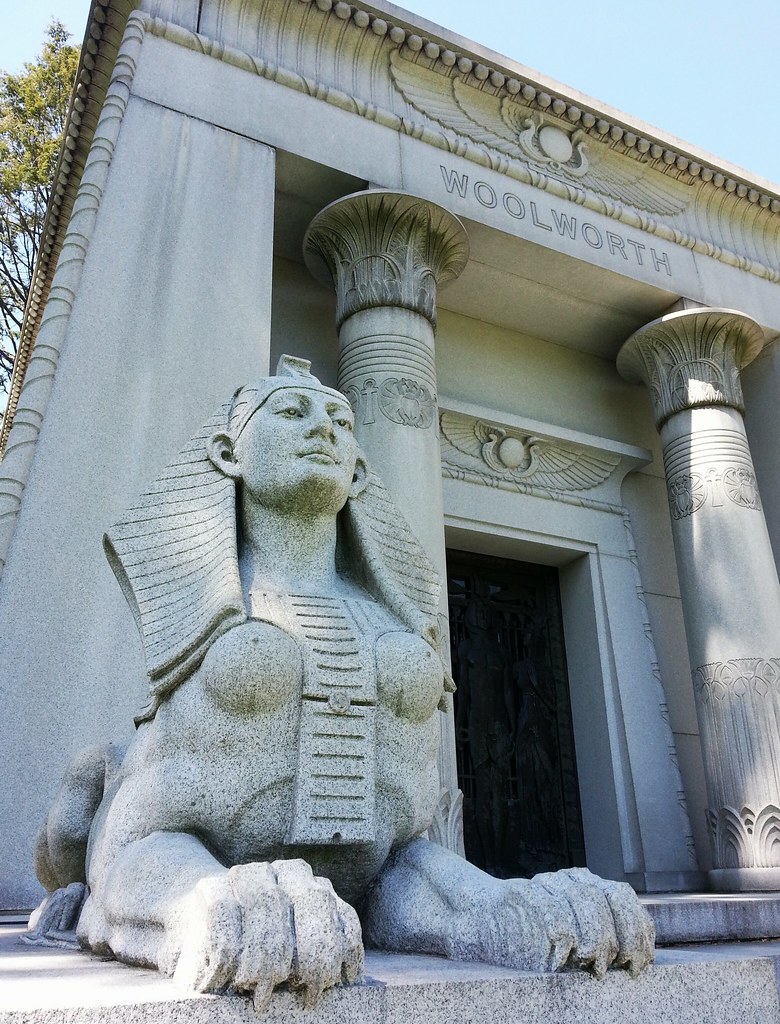
This is one of a pair hanging around the entrance to the mausoleum of Frank Woolworth and his family (including his troubled granddaughter and heiress Barbara Hutton, the "poor little rich girl"). Mr. Woolworth, founder of the five-and-dime empire that bore his name, is one of several members of what Woodlawn calls its "Merchant Prince Hall of Fame"; James C. Penney and Rowland H. Macy, among others, can also be found resting peacefully here in the cemetery, Mr. Penney in a used (or "previously owned") mausoleum that he bought from William Randolph Hearst's widow.
Somewhere in the vicinity, I believe, is the pink granite mausoleum of Elvira and Lawrence Wegielski, which for quite a while was the modern-day version of the Evergreens Cemetery's Reed mausoleum. Mr. Wegielski, who passed away in 2010, would make regular visits to Woodlawn
every Tuesday, Thursday and Sunday, both to care for the site and to spend time with the spirit of his dead wife.There's a beautiful twist at the end of the NY Times's 2003 account of their relationship, from which I've quoted above. Take a read!
''A lot of people say, why do you have to go down to the cemetery three times a week?'' he said. ''This seems to relieve me. I come down, I don't bother anybody, I sit down, I bring soda with me, oranges, whatever. I have lunch with her.''
When the season calls for it, he decorates. Last Christmas, in addition to two ornamented trees, he installed a talking wreath on the door of the mausoleum, so that passers-by who triggered a motion detector were greeted with a hearty ''Merry Christmas.'' One security guard, on night patrol on the pitch-black grounds, was so startled he pulled out his gun. Daytime visitors were alternately spooked and delighted.
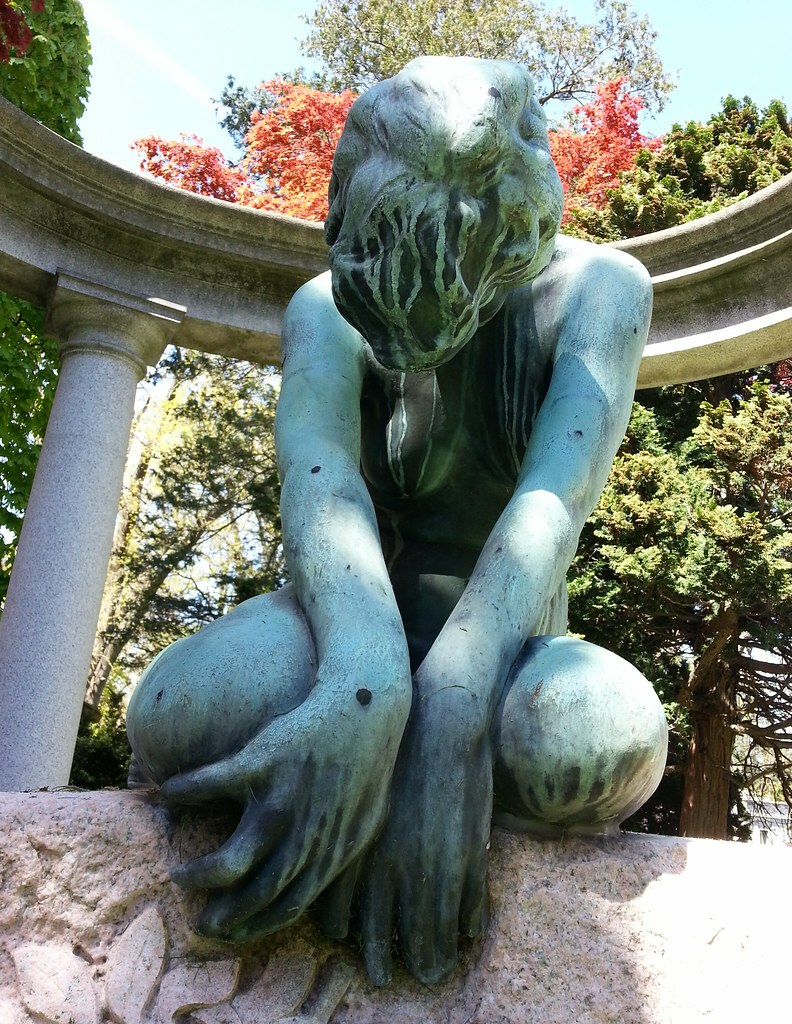
That's the name of this Sally Farnham sculpture marking the graves of Vernon and Irene Castle, a famous ballroom dancing duo who starred in 1914's Watch Your Step, the first Broadway show written by Irving Berlin, a fellow Woodlawner. The Castles' time together was cut short, however, when Vernon, a captain in the British Army's Royal Flying Corps, died in a plane crash while training an American cadet in Texas during World War I.
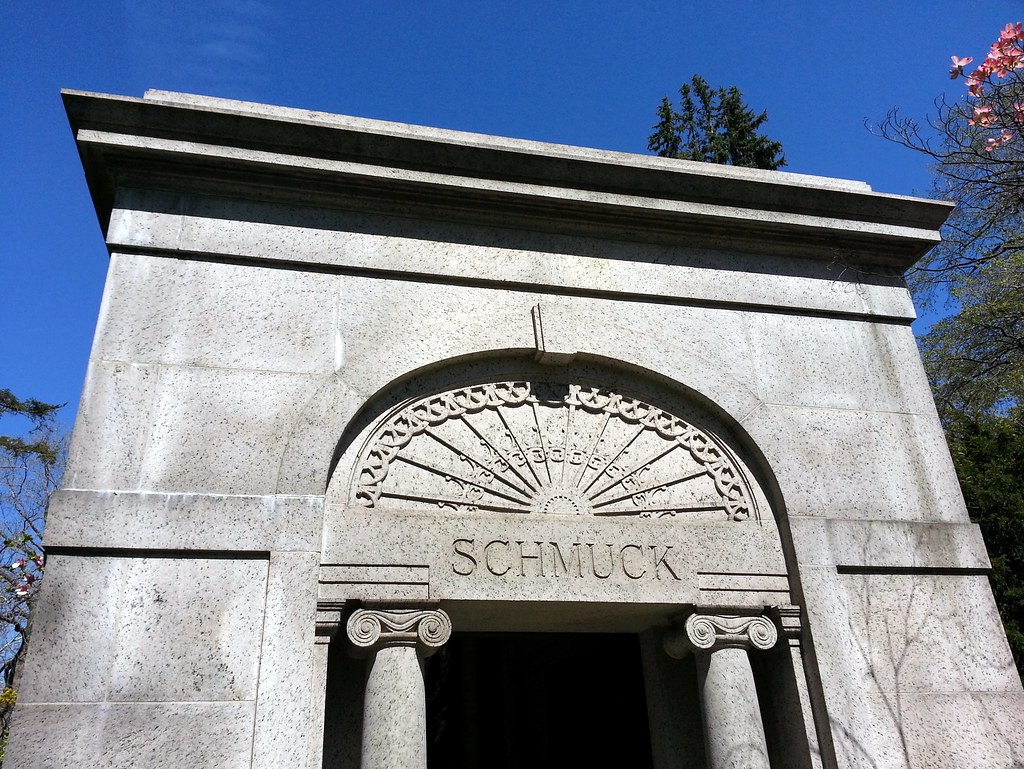
When I spotted this mausoleum, there was a worker inside cleaning it. I didn't want to take him by surprise, so I said hi and told him I was going to snap a photo.
Him: No, you can't do that.
Me: I can't?
Him: I don't think you can take a picture of an open one without permission.
Me: Oh, that's OK. I'll just get the top part here.
Him: [Stepping outside and looking up] Ah, you want a picture of the Schmuck, huh?
Me: Well, let's not cast aspersions on the character of the dead [is what I wish I had said].
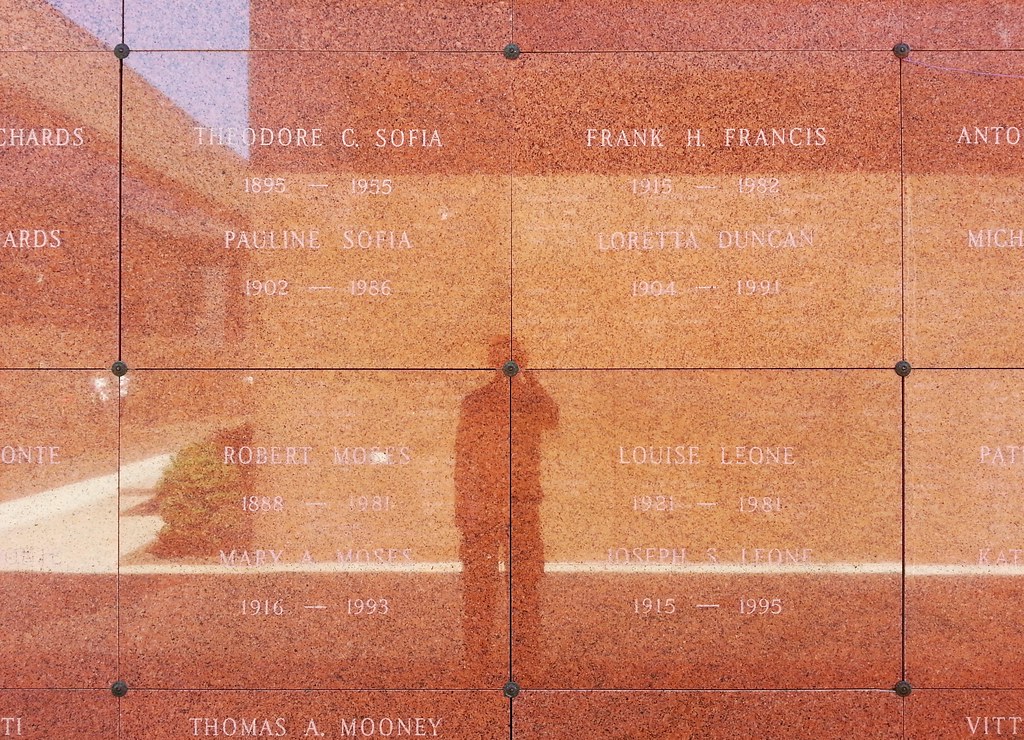
Here lies Robert Moses, one of the most controversial characters in the history of New York. This might seem like a surprisingly modest resting place for a man of such power and influence, but who needs a silly little mausoleum when you've built yourself a monument out of the entire city?

I believe this is the building whose construction prompted Leona Helmsley to sue Woodlawn and move her husband's remains up to a new $1.4-million mausoleum in Sleepy Hollow Cemetery.
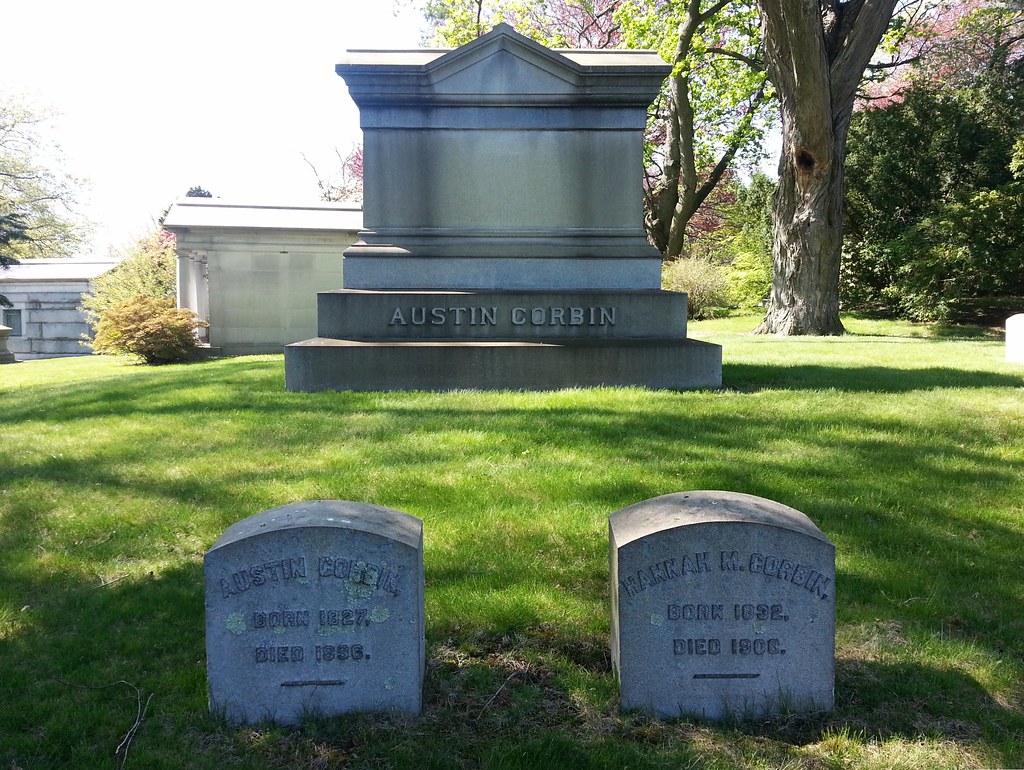
Railroad tycoon, developer of Manhattan Beach, and president of the American Society for the Suppression of the Jews — wait, strike that last one.

The "fabled robber baron", entombed inside a mausoleum modeled after the Maison Carrée

This was originally the Methodist Episcopal Church of Woodlawn Heights. Take a look at the battlements on top of the building; are those chutes for pouring boiling liquids on the heads of invading Presbyterians?

Each manhole cover commemorates one of the 23 workers, almost all of them sandhogs, who have died thus far during the decades-long construction of Water Tunnel No. 3, the biggest public works project in the city's history. (There is a 24th death also associated with the project — a 12-year-old boy who fell down a 500-foot shaft while playing in a construction site.)
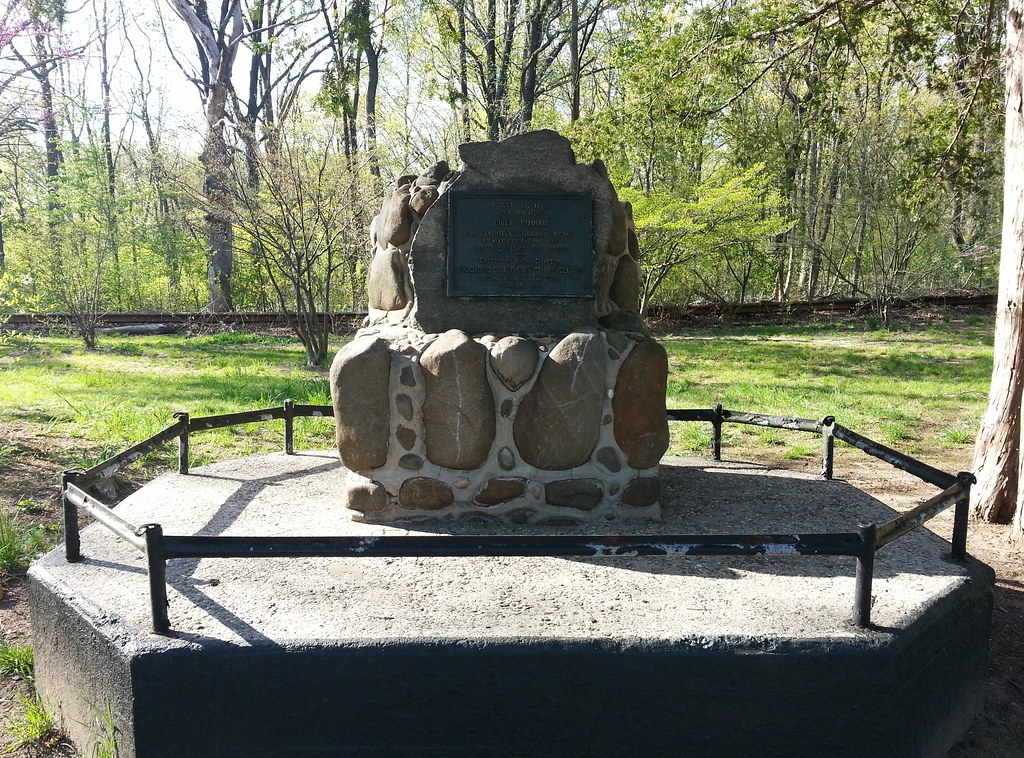
The plaque on this memorial at the edge of Van Cortlandt Park reads:
AUGUST 31, 1778.
UPON THIS FIELD,
CHIEF NIMHAM
AND SEVENTEEN STOCKBRIDGE INDIANS
AS ALLIES OF THE PATRIOTS,
GAVE THEIR LIVES FOR LIBERTY.

A good sign you're in Woodlawn (the neighborhood, not the cemetery)


